Content
Plum is a fruit crop, a place for which every amateur gardener finds on his personal plot. If you choose the right variety, plums can be grown in most regions of Russia. Breeders have created a large number of winter-hardy varieties and hybrids, zoned for the conditions of a long frosty winter. This fruit crop is relatively fast-growing, which means that a few years after planting, you can count on the first significant harvest.
A variety of varieties with fruits of various colors and ripening periods, unpretentious care, make the plum one of the most common crops in amateur and industrial gardens. For the middle lane, it is preferable to choose plum varieties with early and medium-early ripening periods, so that the peak of fruiting ends before the first frost.
The content of the article:
- 7 best varieties of plums
- Early varieties of plum
- Mid-season varieties
- Late plum varieties
- Yellow plum varieties
- Chinese plum
- Other varieties of plum
- How to choose the right plum sapling?
- Basic requirements for seedlings
- Rules for the transportation and storage of seedlings
- conclusions
7 best varieties of plums
These varieties are distinguished by increased resistance to diseases and pests, good winter hardiness and dessert fruit taste.
-
Fast-growing. An early variety, ripening by 1-2 decades of August, has exceptional frost resistance. The variety is not affected by fruit rot, has increased resistance to major diseases and pests of stone fruit crops. Fruits of a reddish hue with yellow sweet pulp weighing up to 30 g. Plum of this variety tolerates drought, during the period of lack of moisture, neither growth nor fruiting suffer.
-
Yakhontovaya. Plum of this variety has excellent frost resistance and resistance to insect pests and diseases of fruit crops. Fruits of yellow color have a light waxy bloom, a pronounced sweet and sour taste, reach a mass of 30 g. Plum of the Yakhontovaya variety is drought-resistant, for 3 years after planting, 50 kg of fruits can be harvested from the tree.
-
Tula black. The variety is characterized by a high level of immunity to major diseases and pests of stone fruit crops, taste and frost resistance are somewhat lower than those of previous crops. The main purpose of dark blue fruits of sweet and sour taste is to use for preparations, preparation of dried fruits. The fruit ripens in mid-September.
-
Chinese. A winter-hardy variety of medium early ripening (mid-September) has a high immunity to pests and diseases of fruit trees. The variety has large, red fruits weighing up to 70 g with a delicate sweet taste.
-
Blue gift. The sweet fruits of this variety weigh a little - only 15 g. They ripen in 1-2 ten days of August, the tree is frost-resistant, rarely exposed to diseases.
-
Giant. Delicate fruits of this variety correspond to the name - they reach a weight of 110 g, have a pleasant taste, and are sweet without cloying. Trees of this variety are not resistant to fungal diseases, winter hardiness is low.
-
Stanley. An old variety of American selection, popular today. It is in the state register of the Russian Federation, it is recommended for cultivation in the south of Russia. Medium-sized trees reach a height of 3 m and have a sparse crown. Large and very large fruits of dark purple and green color are covered with a waxy coating. The pulp of this variety is sweet, dense and aromatic, the stone is separated. The purpose of the variety is to use it as a dessert, for drying for future use, for homemade preparations.
All of the above varieties of plum are distinguished by their early maturity (getting the first harvest from the third year of life), good yield. They are used as a dessert or raw material for preparations: making compote, preserves, jam, pastilles, etc. Plums of these varieties are transportable, that is, they are suitable for transportation over long distances.
|
Early Yakhontova Tula black Chinese Blue gift Giant Stanley |
Early varieties of plum
Early ripening varieties are attractive for commercial use of the crop, as the crop can be sold profitably.
-
July. Plums of this variety are used as a dessert and for preparations. The ripening period of red fruits with yellow and sweet pulp is the end of July. The yield is 12 kg per tree, the first harvest is taken already at the 3rd year of the tree's life. The average weight of ovoid fruits is 30 g. The tree has an average height, average foliage, shoots take an arched shape. Plum of this variety prefers abundant sunlight throughout the day and moderate soil moisture.
-
Zarechnaya early. The ripening period for large blue fruits of this variety is mid-July. The pulp of the fruit is yellow, has a pleasant sour taste, the plums are covered with a waxy bloom. The tree of the Zarechnaya early variety bears fruit regularly, from 3-4 years of age, the average yield is 15 kg per tree. The purpose of the fruits is to be used as raw materials for blanks.
-
Fast-growing. The variety has increased winter hardiness, the fruit ripening period is late July-early August. Small fruits with red skin are transportable, have aromatic juicy pulp. The yield of the variety is 10 kg per tree, the Skoroplodnaya plum begins to bear fruit at the 4th year of life. The purpose of the fruit is to be used as a dessert.
|
July Zarechnaya early Early |
Mid-season varieties
Plums of medium ripening always find their connoisseurs among gardeners, as they have a bright color and rich taste. Fragrant fruits are most often used for harvesting and home winemaking.
-
Souvenir of the East. The table variety obtained as a result of selection work is characterized by a high yield (up to 40 kg per tree) and large, beautiful fruits with crispy, sweet pulp. The crown of the tree is low, located at a height of no more than 2.5 m. The color of large fruits is dark blue, weight - up to 40 g, the color of the pulp is yellow. The purpose of the crop is to use it as a dessert, technical processing.
-
Romain. Used in amateur gardens, ripens in the 2nd decade of August. The variety is distinguished by regular fruiting, has a reddish foliage. High quality fruits of medium size (up to 25 g), have a red skin and the same color flesh. Used for dessert and for processing for the winter.
|
Souvenir of the East Romain |
Late plum varieties
Most often they are used for conservation and preparation for the winter in the form of dried fruits, they have good frost resistance. Gardeners of the middle lane and northern regions should be selective in choosing late-ripening varieties, since they can lose most of the harvest due to early September frosts.
-
The president. The ripening period is mid-September, the tree of this variety is extremely productive, with good care you can get from 40 to 70 kg of large blue fruits with juicy yellow pulp. The purpose of the fruits is universal, suitable for obtaining prunes, long-term storage and transportation.
-
Empress The tree of this variety is tall, up to 4 m in height, ripening period is 2-3 decades of September. Plum of this variety begins to bear fruit at 4-5 years of age. It gives about 20 kg of dark purple large fruits with yellow and juicy pulp (up to 50 g). Purpose - processing and procurement.
|
The president Empress |
Yellow plum varieties
Plum of yellow varieties resembles cherry plum in color, but these two crops are radically different from each other, both in taste and in appearance.
-
Egg. The tree of this variety perfectly adapts to unfavorable weather conditions. Large, round fruits of mediocre taste ripen in late August and early September. They cannot be stored for a long time, they deteriorate already 4-5 days after collection. The beginning of fruiting falls on the 6th year of the tree's life. The purpose of the fruit is processing for canning.
-
Altai Jubilee. It takes root equally well both in the south and in the northern regions. The early ripening variety has small yellow-red fruits with juicy, friable flesh. The beginning of fruiting is 3 years of the tree's life. It is susceptible to chlorosis and pest attacks. Plum of this variety is not transportable over a long distance.
-
Honey white. The taste of the fruit is consistent with the name, its pulp is juicy and sweet. Tall tree (up to 5 m), early ripening, round, medium-sized fruits. The variety has a high yield, winter hardiness.
|
Egg Altai Jubilee Honey white |
Chinese plum
This culture is a rarity in our gardens. Its fruits are attractive and delicious. The Chinese inhabitant is environmentally friendly, more frost-resistant, early in fruiting. This type of plum is characterized by an unusual flowering: the crown is covered with a dense ball of inflorescences, making the landscape spectacular and unique. The flowering period falls on rainy, cool weather, so flowers that are not able to self-pollinate do not receive the help of insects. To solve this problem, cherry plum should be planted next to the Chinese plum, it is a reliable pollinator. The fruits of the plant are red or yellow, heart-shaped. The pulp is juicy, with an adherent bone and a special taste.
Sorts of Chinese plum: "Red ball", "Skoroplodnaya", "Red meat", "Golden ball", "Jubilee", "Seedling Shiro". The Golden Ball tastes like pineapple.
Found a mistake in the text? Select it and a few more words, press Ctrl + Enter
Other varieties of plum
The wide range of plum varieties offered by breeders allows the selection of seedlings for different climatic conditions.
-
Top hit - a late-ripening variety with large egg-shaped fruits (up to 80 g) with tasty pulp with a slight sourness.
-
General's - a frost-resistant variety for technical purposes, has small red fruits with soft pulp, making them non-transportable. Low-growing trees are frost-hardy, they are distinguished by abundant flowering at the end of May.
-
Morning - the variety has medium-sized green-yellow fruits with yellow juicy pulp.
-
Nenka - a high-yielding and frost-resistant variety with medium-sized fruits (up to 22 g). The tree is medium-sized, the crown has a wide pyramidal shape.
-
Alyonushka - the variety is derived from the Chinese plum, so the leaves of the tree with a spherical crown are similar to the leaves of a peach. Sweet large fruits of dark pink color have an inseparable stone.
-
Chemalskaya large - a fast-growing variety, yields a harvest for 3-4 years, frost-resistant, needs pollinating varieties. Both the buds and the wood are frost-resistant, the tree needs sufficient watering.
-
Spike-shaped blue suite - a high-yielding mid-season variety with juicy and sweet fruits weighing up to 60 g. The crown of the tree is compact.
-
Red ball - a dessert variety of large-fruited plum with rounded red fruits with a juicy, light yellow pulp. The tree is medium-sized, up to 2.5 m tall, the fruits are transportable.
-
Eurasia 21 - a tall tree with red-burgundy juicy and sweet-sour fruits with a waxy bloom. Fruit weight up to 35 g.
-
Tula black (Bryansk late) - a high-yielding, self-fertile variety with an average ripening period. It has medium frost resistance, dark blue oval fruits with reddish flesh.
-
Blue gift - mid-season, self-fertile, high-yielding variety. Large fruits have excellent taste, dark purple color.
-
Early ripening red - early maturing self-fertile variety of folk selection ripens in August. Oval fruits with sweet firm flesh are purple in color.
-
Oh yeah - an unpretentious early ripening variety, even on loamy soil, gives high yields. Requires the introduction of a large amount of organic matter and sufficient watering. The stunted tree is annually strewn with purple fruits with a fleshy sweet and sour pulp.
-
Kuban legend - a medium-sized tree has a pyramidal crown. Egg-shaped red-violet fruits with green flesh reach a weight of 35 g.
-
Vicana - the variety is zoned for the northwestern regions. A stunted tree has a thin weeping crown. The mass of oval burgundy fruits reaches 25 g, their stone is easily separated from the pulp. Plum is suitable for both dessert and canning.
-
Valor - mid-season variety of Canadian selection. Large egg-shaped blue fruits with juicy greenish-creamy flesh reach a mass of 50 g.
-
Memory of Timiryazev - a medium-sized tree with a weeping crown has oval juicy fruits with a yellowish pulp. Plum stone with lilac skin is easily separated from the pulp.
-
Hungarian - a transportable variety intended for the production of prunes. The dark red oval fruits have a sugary firm flesh with a sweet taste. The bone is easily detached.
-
Mirabel - plums of this variety are similar to cherry plum, but unlike it they have a sweet pulp and an easily separated stone. Small fruits are oval in shape with pointed ends.
-
Ternoslum - a low-growing tree with excellent adaptability to various growing conditions. The variety is unpretentious to care, has a high yield, its purpose is conservation.
-
Damascene - has oval fruits of various colors (white, black, blue, yellow).
-
Canadian plum - the variety is self-fertile, needs additional pollination, due to early flowering it is not afraid of spring frosts.
-
Burbank Giant - a frost-resistant diploid variety with large fruits of excellent taste. Resistant to monoliosis.
-
Kabardinka - the variety was created by breeders of the Stavropol Territory and Kabardino-Balkaria. Mid-season, ripens in mid-August. Spherical fruits have a very tasty pulp, reaching a mass of 45 g.
-
Angelina - the variety is characterized by a powerful crown that needs to be shaped to accelerate fruiting. Plums of this variety are early-growing, begin to yield the harvest 3 years after planting. The fruits are similar to those of cherry plum.
-
Mashenka - a medium-sized tree of early ripening. Dark pink fruits with yellow flesh have an excellent dessert taste.
|
Top hit General's Morning Nenka Alyonushka Chemalskaya Spike-shaped blue suite Red ball Eurasia 21 Tula black Blue gift Early ripening red Oh yeah Kuban legend Vicana Valor Memory of Timiryazev Hungarian Mirabel Ternoslum Damascene Canadian plum Burbank Kabardinka Angelina Mashenka |
How to choose the right plum sapling?
The first step towards future high yields is the selection of a healthy seedling, prepared according to all the rules for sale and transportation. It is best to purchase young plum trees from nurseries where they are cultivated by professionals.
The initial examination of a plum sapling is an assessment of the condition of the bark and kidneys.The bark should not be damaged, and the buds should be slightly swollen and greenish when purchased in spring. Dry, dry buds are a sign of death or freezing of the tree.
Basic requirements for seedlings
A plum seedling suitable for planting can be annual or biennial. An annual seedling has a thin, even trunk without branches. A two-year-old seedling is a trunk (at least 2.5 cm in diameter) with 3-4 branches - the rudiments of skeletal branches 50-60 cm long. Both those and others take root well in a new place, although two-year-olds begin to bear fruit faster. Three-year-old plum seedlings are more sensitive to replanting.
When choosing a seedling, special attention should be paid to the health of the roots. The root system should be fibrous, with a central root and many branches and thin roots.
Rules for the transportation and storage of seedlings
Optimal terms for purchasing and planting plums in the middle lane:
-
End of March - beginning of April;
-
End of September - beginning of October.
For the south of Russia, these terms are shifted by 2-3 weeks forward (in spring) or backward (in autumn).
Seedlings with a closed root system take root best. A reliable seller will always cover the roots of the seedling with a clay mash before selling it to protect it from drying out and damage during transportation. If the root system is not protected, and the seedlings need to be transported, their roots are wrapped in a damp cloth, grass, straw. If the root system is dry, there is a risk of death of the seedling.
conclusions
A large assortment of zoned varieties of plums, suitable for growing in most regions, allows you to purchase planting material to your liking. The choice of a high-quality seedling with the expected characteristics, proper planting and care will certainly reveal the possibilities of the variety, and help to get a good harvest.
The author of the article: Alexey Kuzmin, expert agronomist, specially for the site
Plum is one of the most useful and delicious fruits, which contains a large amount of vitamins B, C, E, P, as well as trace elements - magnesium, potassium, calcium, iodine, zinc, manganese. And they are also very beautiful trees, the care of which is not very demanding.
And the taste of plums can be very different - sour, sweet and sour, sweet, tart and soft. If you plan to grow such a tree in your garden, first of all you need to figure out what varieties of plums are, which are suitable for central Russia or for growing in Ukraine, or in another country with a southern or temperate climate.
In this article, you will find a detailed description of the best varieties of plums from which you can choose the right ones.
A little about classification
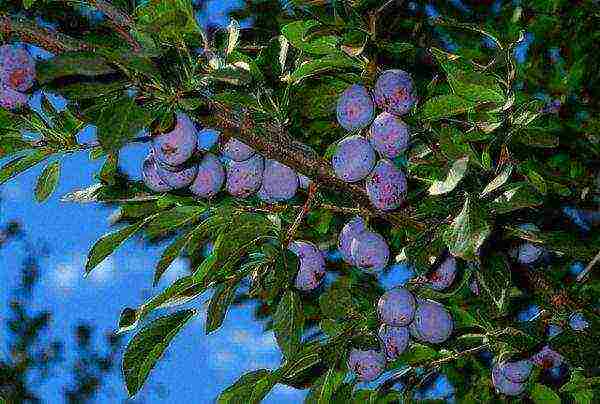
The principles for classifying these fruit trees are very extensive and include the following characteristics:
- Suitability for food. There are varieties that are considered edible, conditionally edible, and there are also exclusively decorative ones. This point must be clarified by the photo with the name and description before choosing a variety of plums for growing on your site.
- Taste qualities. Here you need to understand that there are varieties, the fruits of which are eaten fresh, but there are - exclusively culinary, that is, for the preparation of preservation (jam, jam, compote, wine, dessert). But among all the selection, you can pick up a universal option, which will be more acceptable when it comes to growing in your own garden.
- Ripening terms... Depending on the characteristics of the climatic zone, as well as personal household habits and the availability of free time in a particular season, you can choose early, mid-season and late varieties of plums. There are even frost-resistant species.
- Color, size, fertility. Here it is already a matter of personal taste for everyone, since you can choose red, blue, yellow varieties of plums, with large and small fruits, with an abundant or not very large harvest - who likes which more.
Only after having dealt with all these criteria and having determined for yourself the priority characteristics of the tree, you can begin to familiarize yourself with the names, photos and descriptions of plum varieties.
Early
All early varieties bear fruit in July and early August. The best according to breeders and gardeners can be found in the description below.
July

The tree has an average height and medium foliage, grows well in areas with abundant sunlight on moderately moist soils. When planting, you can expect from 3 years of cultivation for a yield of 12 kg per tree.
Red fruits with sweet yellow flesh ripen at the end of July. The average weight of the fruit is about 30 g, the shape is ovoid. The fruit is best suited for making desserts and preserving.
Zarechnaya early
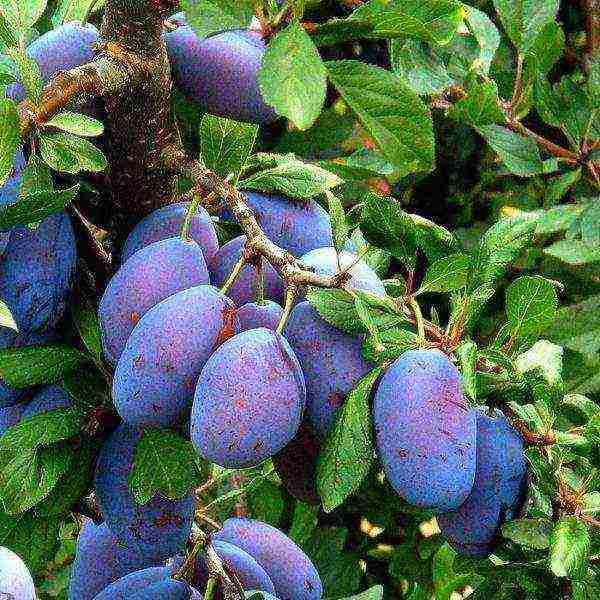
This kind of plum has fruits with yellow pulp and a pleasant sour taste. There is a slight waxy coating on the surface of the fruit. Trees bear fruit regularly, giving off an average of 15 kg of plums per year, which ripen by mid-July. Zarechnaya early is best suited for harvesting conservation.
Early

This variety of plum is distinguished by its red fruits with juicy aromatic pulp. Ripening occurs from late July to mid-August. Productivity - average, from 4 years of growth is about 10 kg per tree. This variety is a dessert one.
Etude
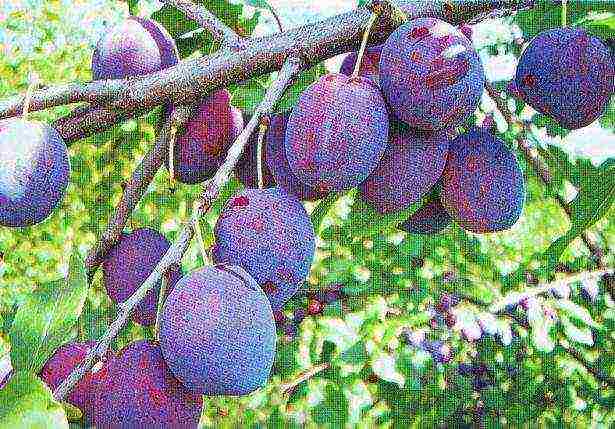
The trees of this early variety are distinguished by a dense crown and medium height. The fruits are purple-red, oval in shape, have a thick waxy bloom. The pulp is juicy, dense, there is a slight sour taste. This variety is favorably distinguished by such qualities as frost resistance and good immunity to various diseases, the ability to store fruits for up to 2 months in a cool room, as well as a high yield - about 20 kg from one tree.
Peach
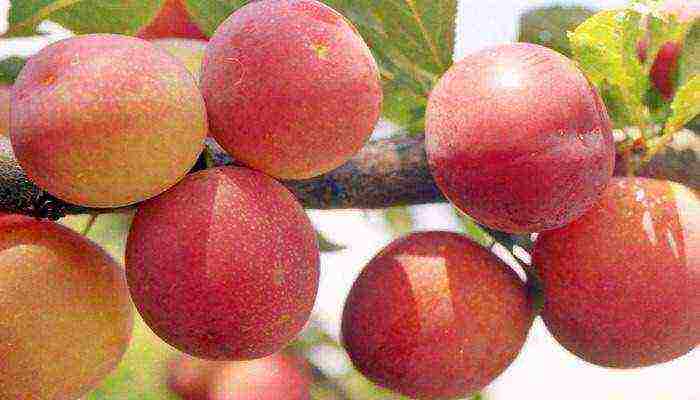
This is a medium-sized plant with a not very dense crown and large fruits weighing about 40-50 g. But there are also fruits weighing up to 70 g. Fruits are very beautiful - yellow-green, have a purple blush, dense, juicy pulp, sweet and sour taste. An early variety of Peach plum does not withstand low temperatures too well, therefore it will be acceptable, for example, for planting in the Crimea. But it is favorably distinguished by excellent immunity to diseases.
Candy
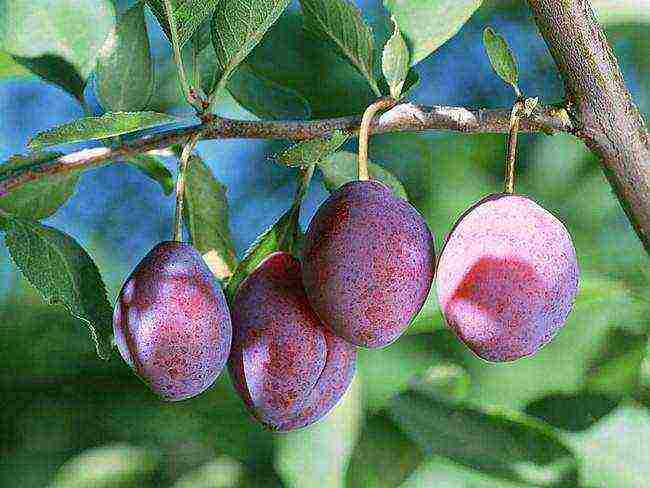
This variety belongs to the category of ultra-early. The trees reach a height of 3 meters, but at the same time they look quite compact. The fruits are medium in size, weighing about 40 g, have a thin burgundy skin and a bluish bloom. This is the sweetest plum with a honey-yellow pulp.
An excellent variety for planting in central Russia and Ukraine, as it firmly tolerates frosts up to 20 degrees and does not succumb to diseases familiar to plums.
Kseniya
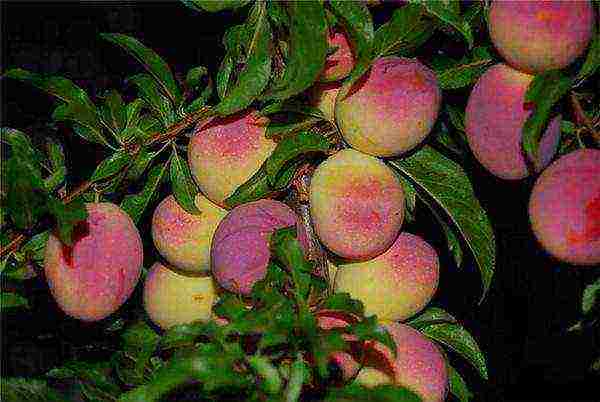
This variety is versatile in terms of the use of fruits. The trees are quite low, the fruit is oval in shape and weighs about 40 g. The color is yellow with a red blush. The taste is juicy and sweet. Fruiting irregularly, but hibernates quite well.
Mid-season
Mid-season varieties ripen from 10 to 25 August.
Souvenir of the East

This is the result of artificial breeding, due to which a very high yield was achieved - an average of 40 kg per tree. The fruits are very large, have a crunchy, sweet pulp. The trees usually grow to a height of 2.5 meters and have a compact crown. Fruit color - dark blue, pulp - yellow, average weight - 40 g. Excellent as a dessert variety and for preservation.
Romain
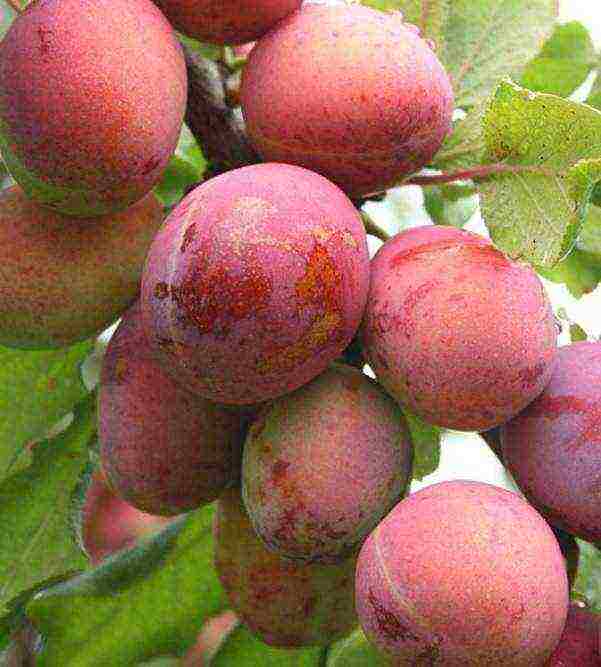
The ripening time of the fruits is the 2nd decade of August. This variety bears fruit regularly. It looks very beautiful on the site, due to the decorative foliage of a red hue. Fruits are small, up to 25 g in weight. A good variety for preservation and as a dessert.
Bogatyrskaya

A self-fertile variety of plum, the trees of which are rather short.Fruits are medium in size, oval, slightly elongated in shape, weighing 40 g, rich purple hue, with a waxy bloom. The taste is sweet and sour. Such plants are rarely affected by diseases, pests, do not freeze, and tolerate transportation.
Late
Late plum varieties are those whose fruits ripen from the third decade of August. In some species, this period can last up to October.
Empress

These are tall trees of 4 meters, the harvest from which is harvested from mid-September in the amount of about 20 kg. They begin to bear fruit only from 4-5 years of growth. The color of the fruit is dark purple, the fruit is large, on average 50 g. This variety is most suitable for technical processing and harvesting.
Anna Shpet
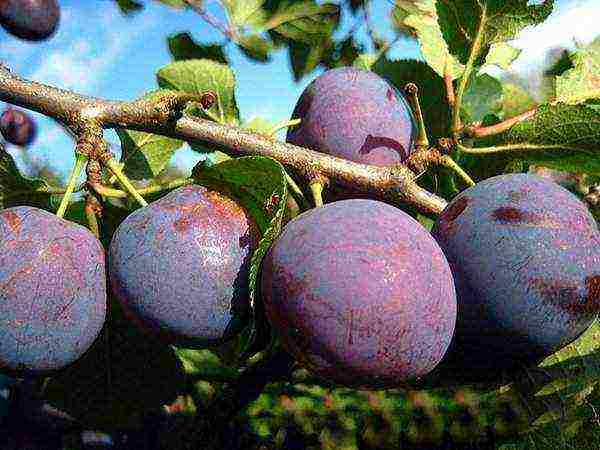
This species belongs to late maturing and very productive, with tall, durable trees. Fruits weighing 50 g, have an oval-ovoid shape with smooth sides, a dense skin of a red-violet hue.
There is a slight coating on the surface, the flesh is of good firmness and has a greenish color. Great for eating raw, for freezing, cooking dried fruits. It tolerates both low temperatures in winter and aridity in summer, but requires good care and prevention of diseases. Suitable plum variety for growing in central Russia.
Top hit
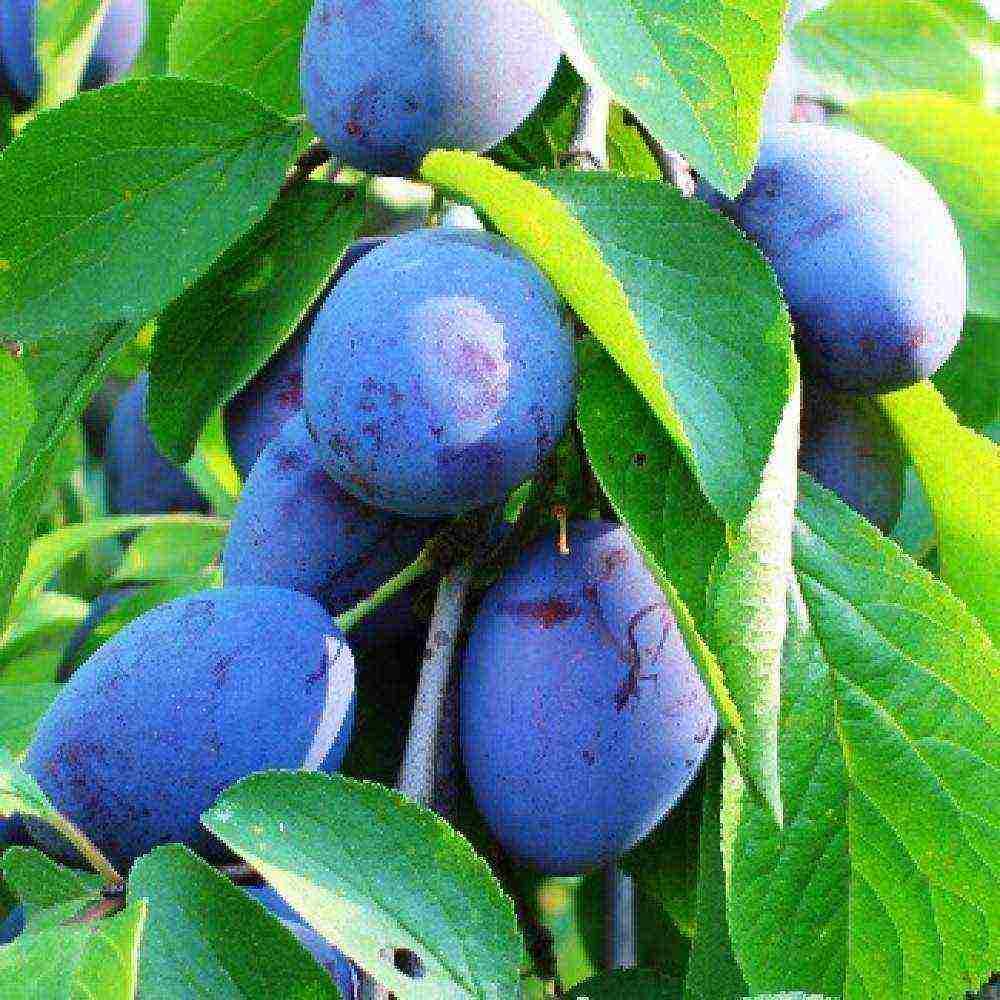
This variety stands out for large fruits up to 80-100 g, tasty juicy pulp with a slight acidity, good long-term storage. Harvested usually in the second decade of September.
The tree begins to bear fruit from 3-4 years after planting. The plant itself is very large and has a spreading crown. Fungal diseases and scabs are usually not affected. It tolerates winter staunchly, therefore it is excellent for growing in Ukraine.
The president
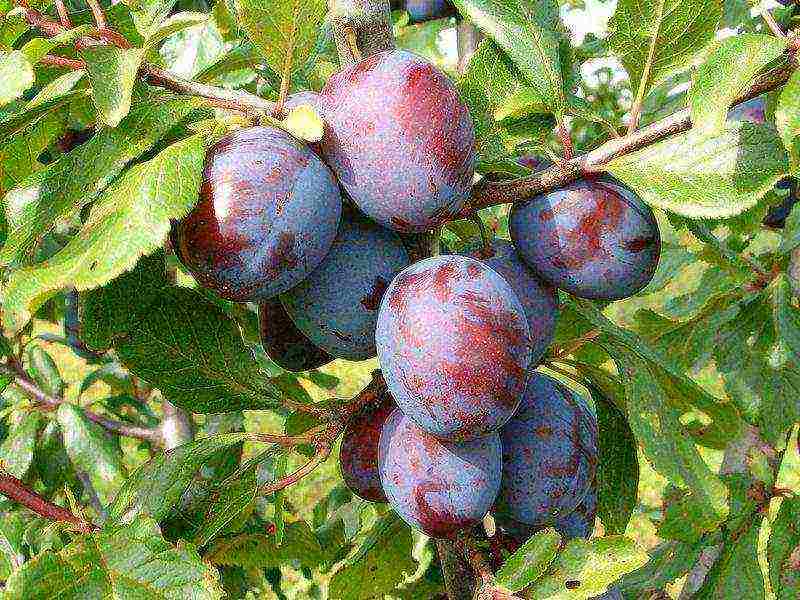
This variety is one of the oldest. It was known back in England in the 19th century. The fruits weigh from 40 to 70 g, uniform, round, can be stored for up to 2 weeks, if they are harvested a week before the final ripening.
But picking the fruit too early is not worth it, as in this case the pulp will be sour, tough and with a rather mediocre taste. The yield is high and increases as the tree matures:
- in a 6-8-year period, you can count on 15-20 kg;
- from 9 to 12 years of growth - by 25-40 kg;
- up to 70 kg from one older tree can be obtained if it is in good health.
The plum variety President is partially self-fertile, develops well in any climatic conditions. Suitable for raw consumption.
General's
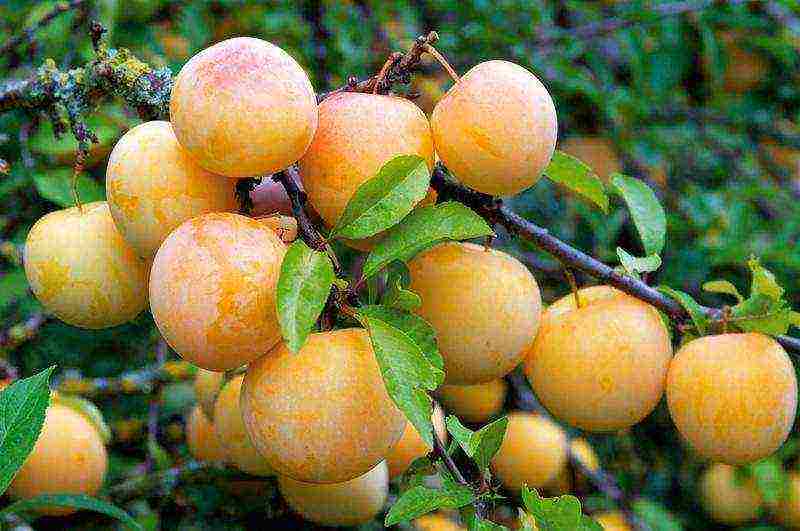
This species is good to grow in the garden for the reason that it is not demanding on the composition of the soil. The main conditions for good growth are sufficient fertility and good loosening of the land. It is better to plant it in early spring.
The trees are compact in size, fruiting with bright orange plums with red barrels weighing 30 g from the age of 5, although some begin to bear fruit even at the age of 3.
Low temperatures tolerate well, but only adult and healthy plants. Young when planted in the fall may not survive. Productivity is high, shedding is low. The seeds are well separated from the fruit and are small in size. Great for making compotes, jams.
Yellow
Yellow plums look very beautiful in the garden. These are the varieties that most often receive positive reviews from novice and experienced gardeners.
Golden ball
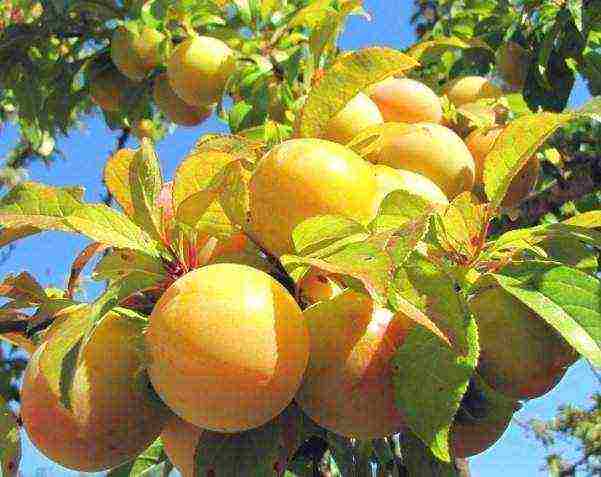
A tall (up to 4 m) tree, the fruits of which have a rich yellow color of the peel and pulp, a pleasant sweet taste, about 60 g in weight and ripen in the first decade of August. The yield is at least 30 kg per tree, since the branches and the fruits themselves are closely located, and somewhat resemble the shoots of sea buckthorn. Of the minuses, the absence of self-pollination and shedding of fruits can be noted.
Egg
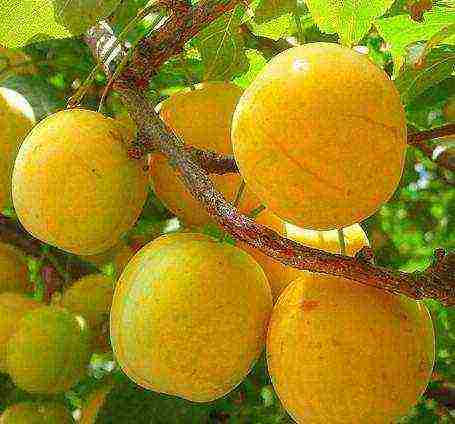
This is a very old variety that has many disadvantages:
- Fruits spoil quickly - already on the 5th day after collection.
- Mediocre sour taste.
- Clingstone.
- The plant is often affected by fungal diseases.
- Begins to bear fruit only from the age of 6.
Nevertheless, it is still grown, since the fruits are excellent for technical processing into marshmallows, compotes. The fruits themselves are medium in size and have a nice round shape, and the yield of this variety is 40 kg per tree.
Altai Jubilee
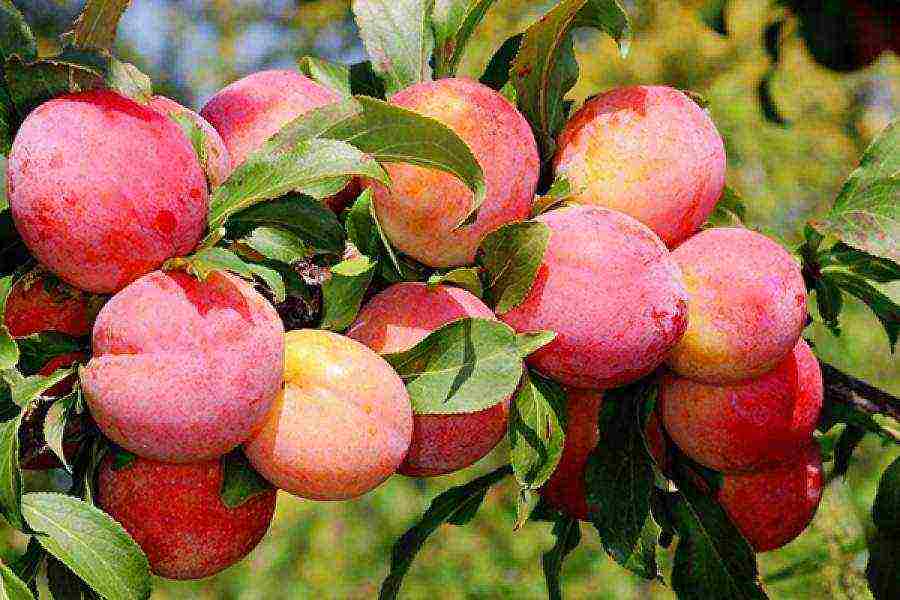
This variety of plum is excellent for growing in central Russia, as well as in the south or in the northern regions. The fruits are yellow in color with a reddish tint, juicy loose flesh. The first appearance of the crop can be expected as early as 3 years of tree development. There are also disadvantages - susceptibility to chlorosis, pests, as well as intolerance to long-term transportation.
Honey white
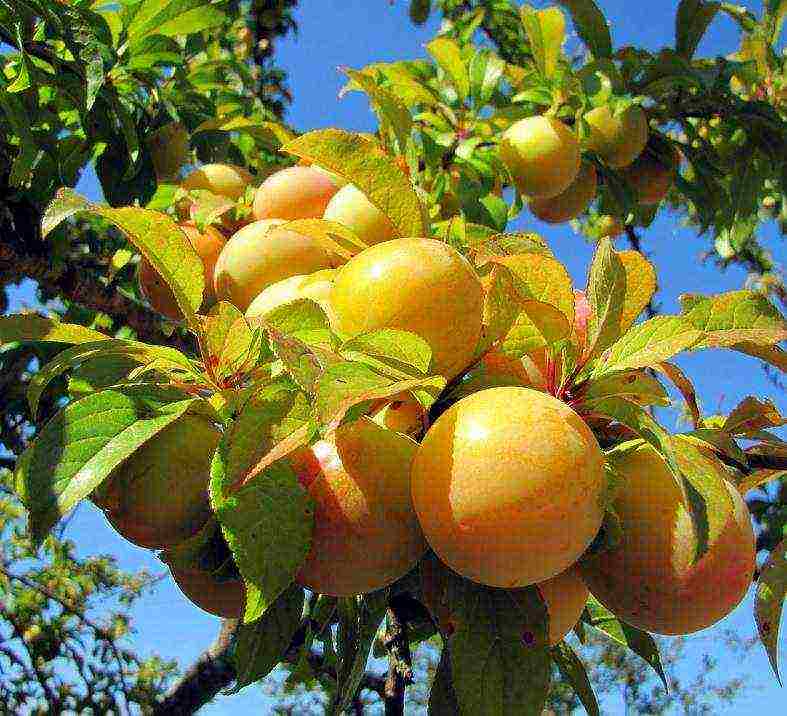
These are very tall trees, up to 5 meters, which give a bountiful harvest and tolerate severe winters well. The name speaks for itself - the fruits are medium-sized and the sweetest, the pulp is juicy. Plums ripen early.
Golden Large
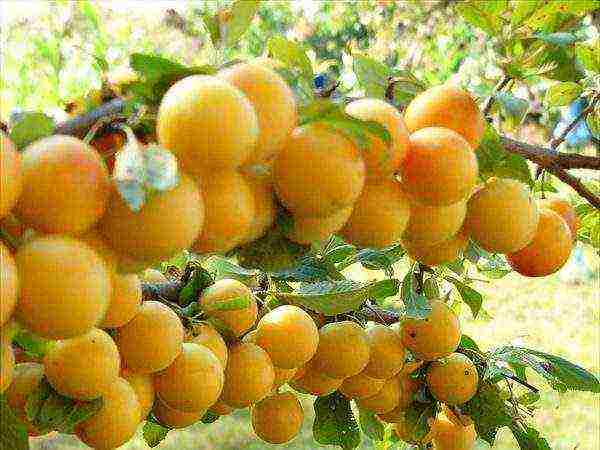
This variety of plums is one of the most popular for cultivation in different climatic conditions, as it perfectly tolerates winter frosts and summer droughts. The palatability of the fruit was rated at 4.8 on a 5-point scale.
Features such as tenderness, juiciness of a pleasant sweet and sour pulp, which literally melts, are noted. The average weight of oval-shaped fruits is 40 g, the color is yellow, with tints of pink, there is a waxy pubescence, which, however, can be easily removed.
Ripening occurs in early October, the yield is about 26 kg per tree. The variety is acceptable for raw consumption and storage.
Yellow afasca
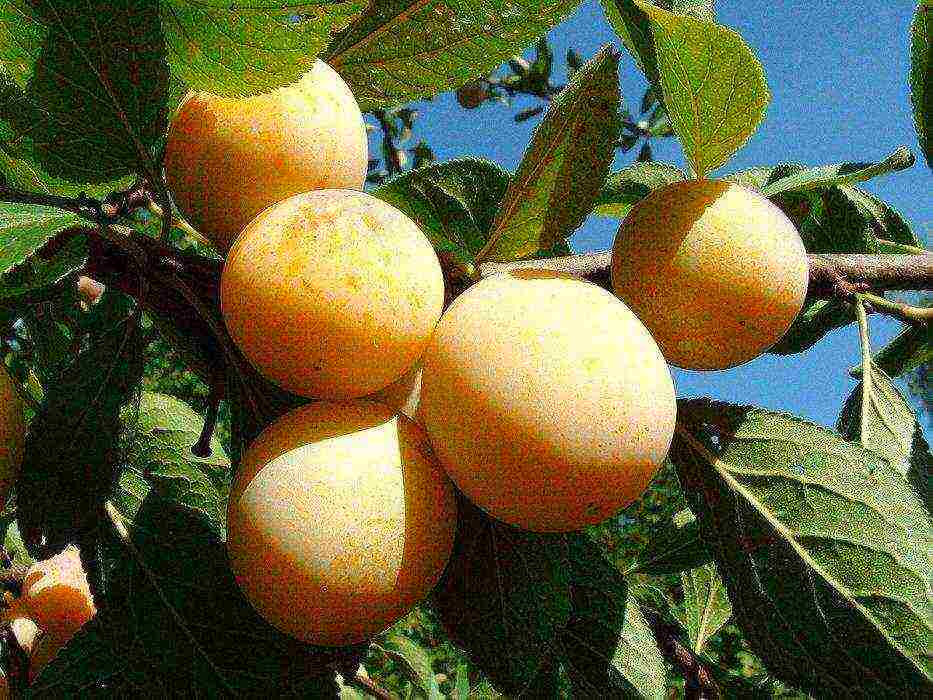
Bred in Bulgaria, but suitable for cultivation in Russia and Ukraine. You can see in the photo that the fruits are quite large, about 60-70 g, the color is yellow with a little green, the taste is sweet, dessert, but they are not stored for very long.
Another important advantage is that you can expect a harvest as early as 2 years of plant life. Winter hardiness, as well as high immunity to sharka and other diseases of stone fruits are additional factors in favor of growing this variety. The tree itself does not pollinate; it is best to use the American Amers variety for this purpose.
Sweet and large
Giant

The name is fully justified by the peculiarities of the species. Fruits in weight reach 110 g, can have both purple and yellow, red tint. The taste is sweet, but not cloying, the flesh is tender. Begins to bear fruit as early as 2-3 years after planting seedlings.
The breed does not differ in winter hardiness and requires careful care, since both fungal diseases and damage to the plant by pests are possible. But all the investment of labor pays off with a bountiful harvest of excellent fruits that can be eaten raw and used for canning.
Kyrgyz excellent
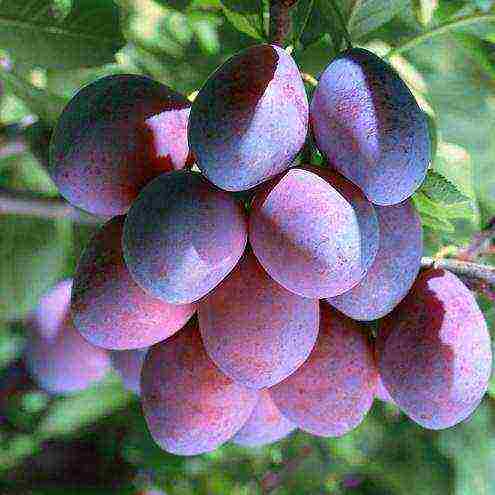
The fruits of this variety are dark red or purple in color, sweetness and large size - 60-100 g. The trees are winter-hardy, give a bountiful harvest, bear fruit in July-August. The plants themselves have an average height, a medium thickened spherical crown.
Ballad
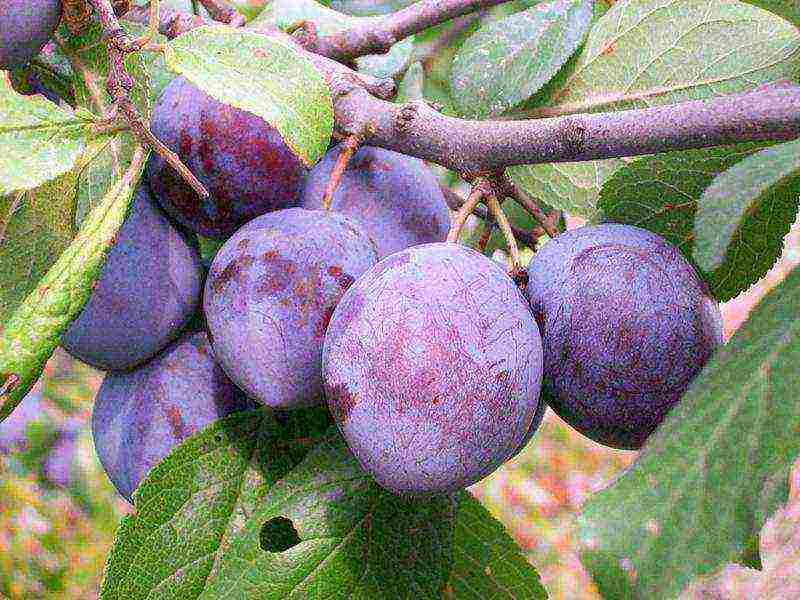
Another sweet variety of plum, however, does not differ in special size - the average mass of fruits of a round shape, red-violet hue is 30-40 g. The stone well departs from the dense, yellow-green pulp. The trees are self-fertile.
Crooman
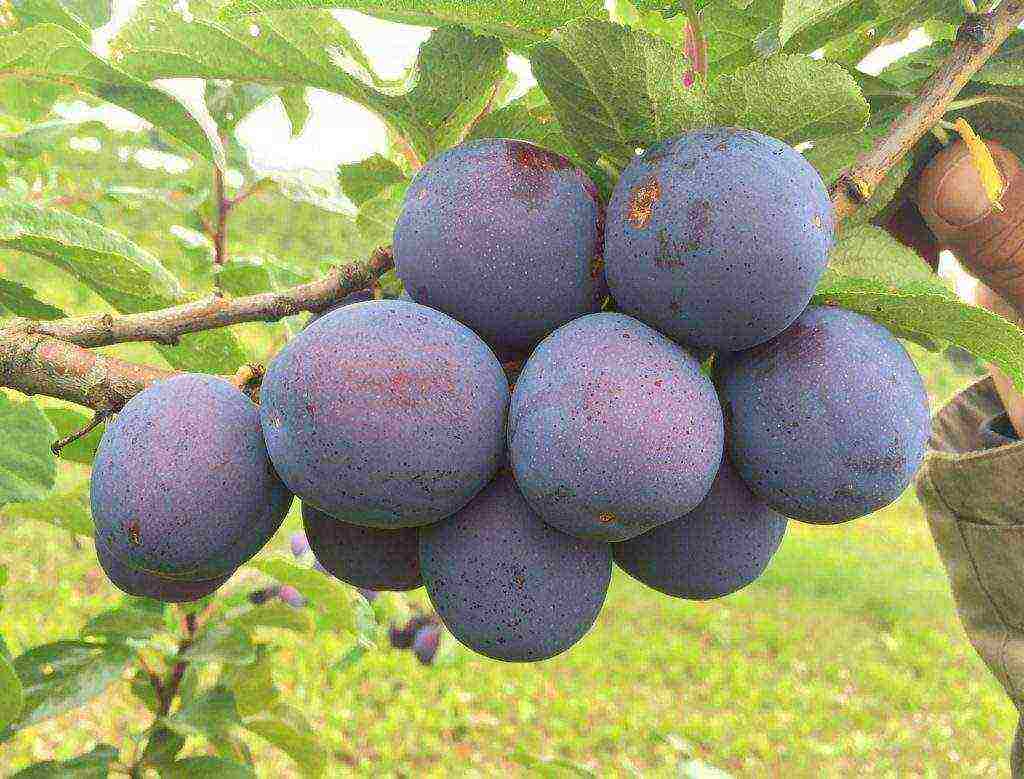
This variety is medium-ripe. The assortment may include dark red, blue integumentary fruits with a waxy coating. At the same time, the pulp is yellow, sweet, dense, and there is a very small bone in it, which is well separated. This plum variety is resistant to the most common diseases of fruit trees.
Greengage
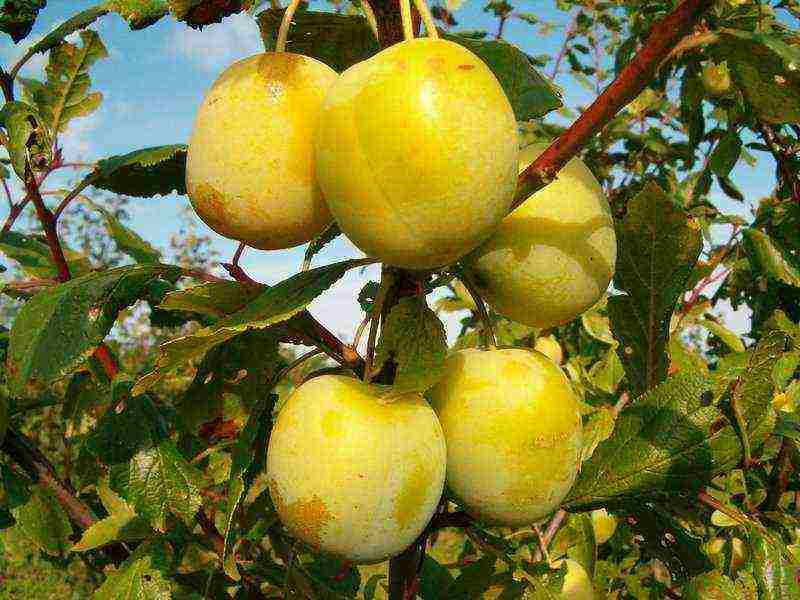
Very sweet, with hints of honey plum with a dense, juicy pulp. The stone is perfectly separated without any effort, the fruits can be green, blue, yellow - depending on the specific subspecies. The crop is stored for a long time, easy to transport.The average fertility of a 10-year-old tree is 25-30 kg. It goes well both as a dessert variety and for processing for conservation.
Other varieties of plums
- Nenka. Medium-sized trees with a wide crown produce small fruits (on average 20 g), but in large quantities. The shape of the fruit is round. The variety is resistant even to severe frosts.
- Volga beauty. Sweetish-sour fruits of a slightly oblong shape have a mass of 40 g and a moderately dense pulp. It is well preserved, the crop can be transported for a long time, it tolerates winter cold.
- Red ball. A large-fruited dessert variety that looks very decorative on the site. Fruits are juicy, with light yellow pulp, transportable. The plant itself is compact - up to 2.5 m.
- Oh yeah. An excellent option for any soil, including loamy. Productivity is excellent: a tree at the age of 10 years can give up to 80 kg of sweet and sour fruits. A low-growing species, for the development and intensive fruiting of which a sufficient amount of organic fertilizers and regular watering will be required.
- Tula black. Self-fertile, high-yielding species with late maturity and average winter hardiness. Fruits are oval, medium-sized, dark blue with reddish flesh.
- Crimean beauty. Medium-resistant plum variety, with a reddish-crimson color of small fruits - about 20 g. The stone is semi-detached. Ripens from late July to late early August. It grows slowly, but it is very resistant to any diseases of plums.
We hope that our review of the best varieties of yellow, red, sweet, large plums of different ripening periods helped you choose the optimal species for your site, and you will not be disappointed with either the fertility of the trees, or their health, or the complexity of care.
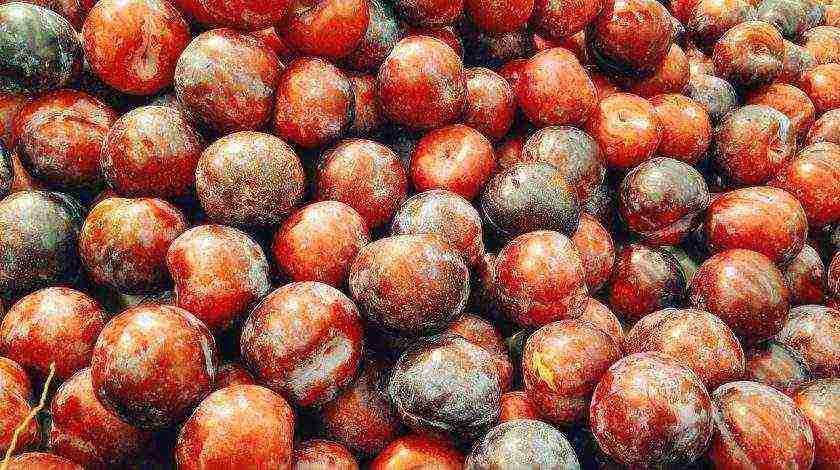
In this article, we will get acquainted with a description of the most popular varieties of plums in our country. Plum is one of the most common crops in the gardens of Russians. It has about 250 species, and its varieties, obtained by crossing, simply cannot be counted. Asia is considered its homeland, but it is firmly entrenched in our areas.
Plum Yellow
People are usually accustomed to seeing a plum of purple, blue shades on tables, store shelves. But there are varieties that have completely different colors. The yellow plum is one of those. It was obtained by crossing cherry plum, wild plum. This hybrid, due to its sweetish taste, is suitable both for the preparation of various sweets and for fresh consumption. Let's consider some varieties of yellow plum.
Honey
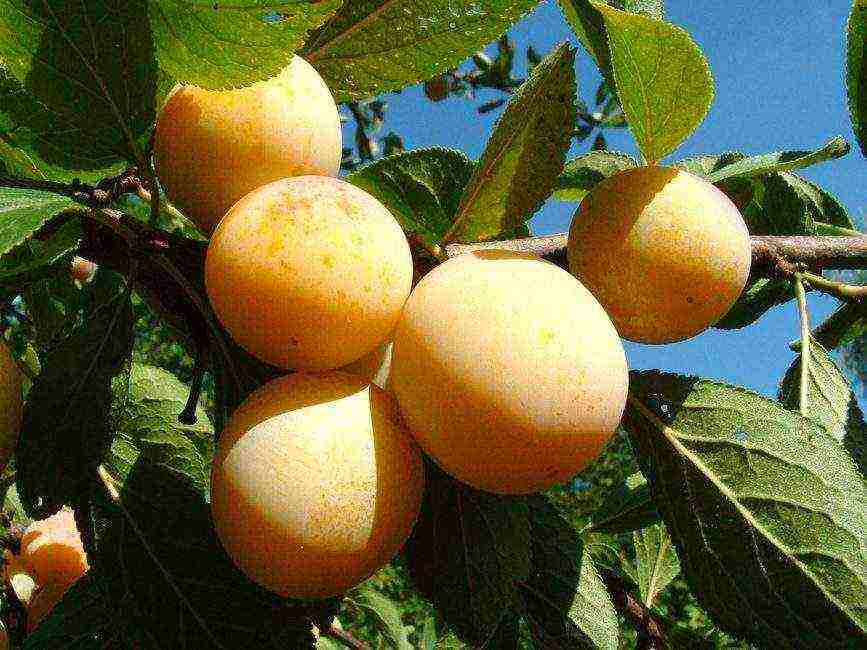
Morning

Firefly

Some sources refer to "firefly" pollinators:
- Kolkhoz renklode
- Lighthouse
- Record
- Renklode is fruitful
Plum Renclode
Under this name, different varieties of one type are combined - homemade plum. Western Europe is considered to be the birthplace of Renklode plums. These are trees with a height of 5 to 7 m. The berries are egg-shaped. Their color, depending on the variety, can be from yellow-green to purple. The peel is matte.
This group received particular value for its taste. Fruits inside are soft, juicy, sweet. The yield directly depends on the weather conditions. They can even bear fruit once every few years.
The most famous varieties from the Renclode group:
- Green
- Enikeeva
- Soviet
- Blue
- Prizedentsky
- Michurinsky
- Karbysheva
- Kuibyshevsky
- Leah
- Tatar
- Ulena
Let's consider some of them in more detail.
Soviet
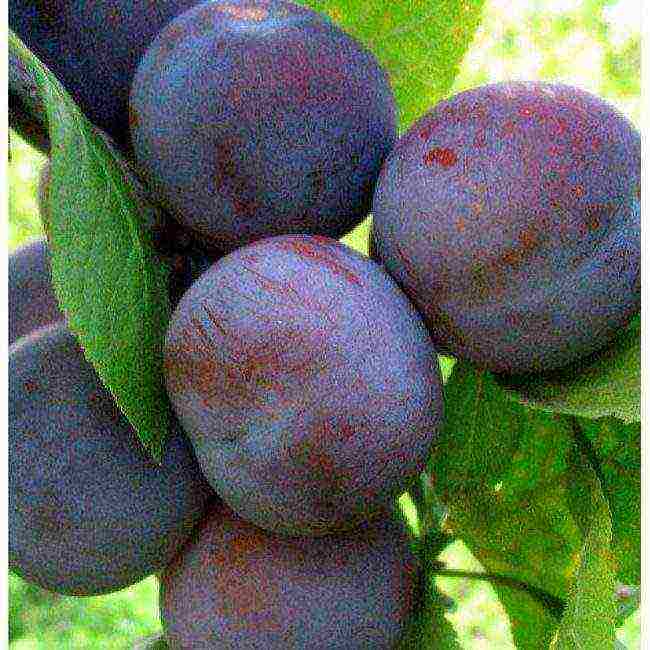
Kharitonovskaya
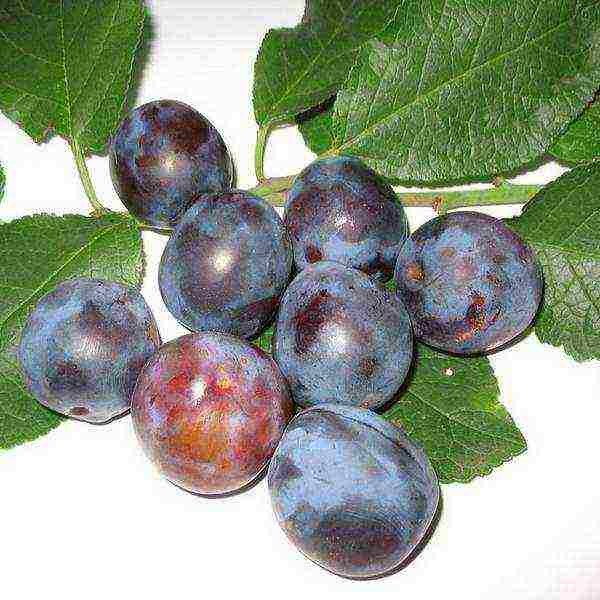
White
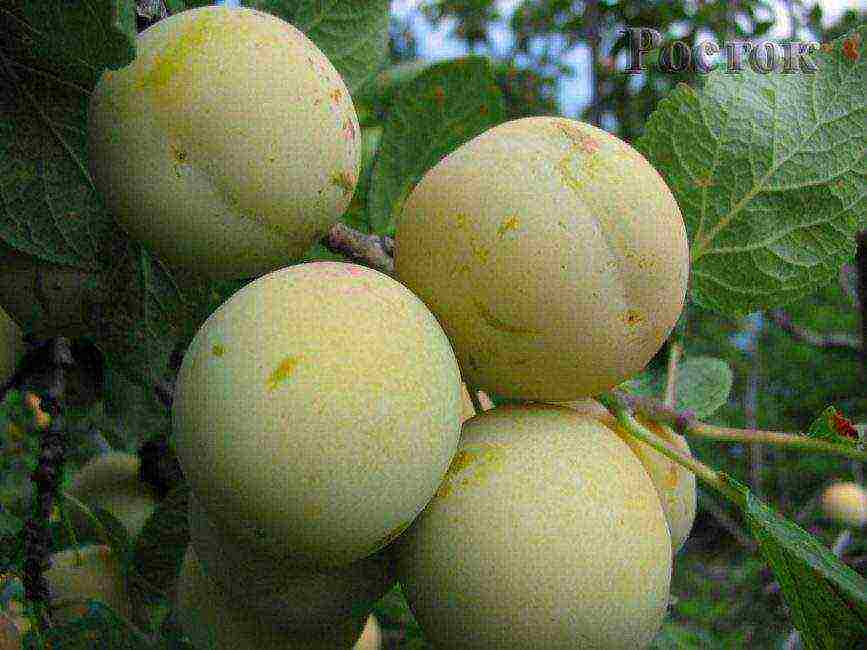
Planting as pollinators:
- Renclaude Green
- Donetsk early
- Renclaude Altana
- Hungarian Donetsk
Plum Hungarian
Vengerka plums are a group of varieties that can grow in different climatic conditions. Their agricultural technology is not difficult, so this group is suitable for growing gardeners for beginners.
Trees up to 6 m high. Their fruits are ellipsoidal, in different shades of blue and purple. Inside, the berries are dense, yellow in color. They bear fruit every year. Most Hungarian fruits do not require pollinator varieties to be planted with them.
The berries of this group of plants are used to make prunes. Hungarians bear fruit well, are resistant to drought, are suitable for storage, transportation, but the first crop can be harvested no earlier than 6 years after planting.
Stanley
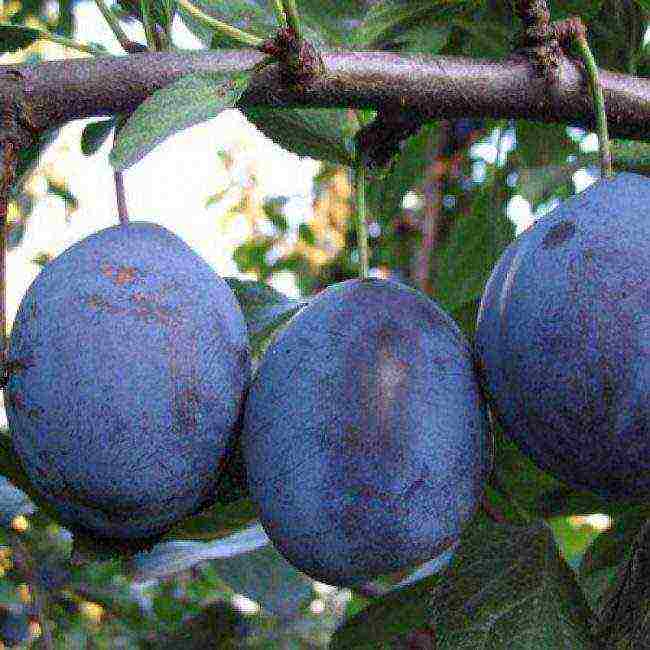
To obtain prunes, this particular variety is most often used.
Plum Columnar
This type of plum appeared in our country several decades ago. But many gardeners liked it. Its main difference can be considered an extremely narrow crown - 80 cm. Columnar plum varieties are convenient to plant in small areas, since they do not have spreading branches. But such plants have a significant drawback - they do not tolerate low temperatures.
Coloniform plum does not differ in a large number of varieties.
The most famous:
- Imperial (pink fruit)
- Mirabelle (yellow berries)
- Blue Sweet (purple fruit)
These are small trees, about 2 m high, give up to 16 kg of fruit. They can be used both fresh and for jam, jam, etc. Fruiting begins at the 3rd year of life. The yield is growing every year.
Imperial
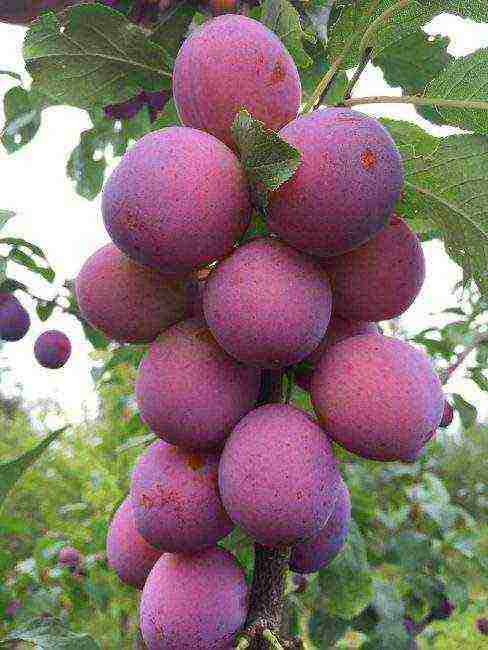
Chinese plum
China is considered the birthplace of this plum. Its varieties are most often common in our country in the Far East, Siberia.
The main features of the Chinese plum are considered to be their early fruiting, rapid growth. The first harvest from trees is harvested 1-2 years after planting. With age, the number of fruits on the plant becomes larger.
In large-fruited varieties, berries reach 120 g. Depending on the variety, their peel can be yellow, red, purple, orange. They are well stored, suitable for long-distance transportation.
The pulp is sweet, with a strong aroma and a grown-together bone that is not easy to separate. But in terms of taste, they are much inferior to homemade plums. Let's consider some varieties in more detail.
Alyonushka

Early
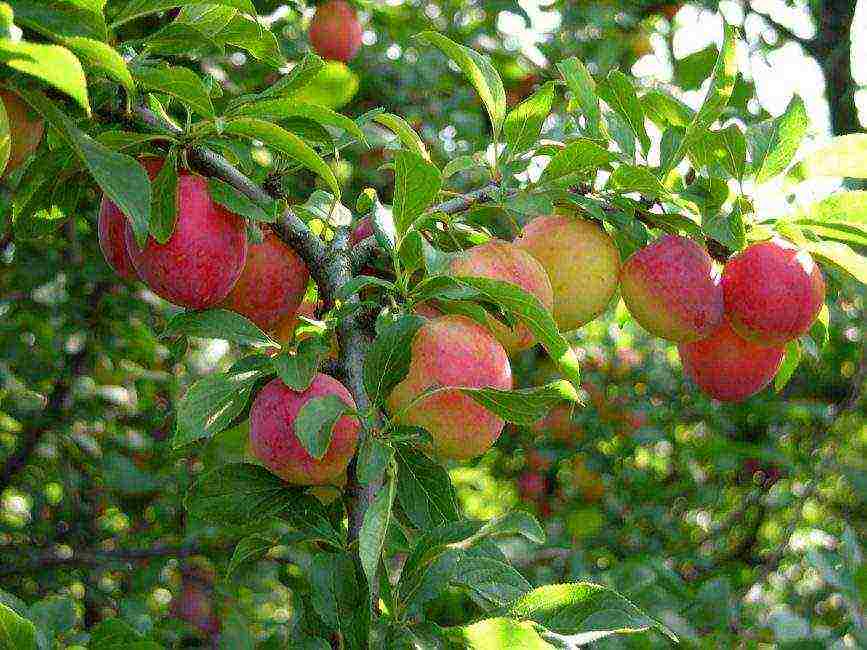
For storage for a long time, the early-fruited plum is harvested unripe.
Souvenir of the east
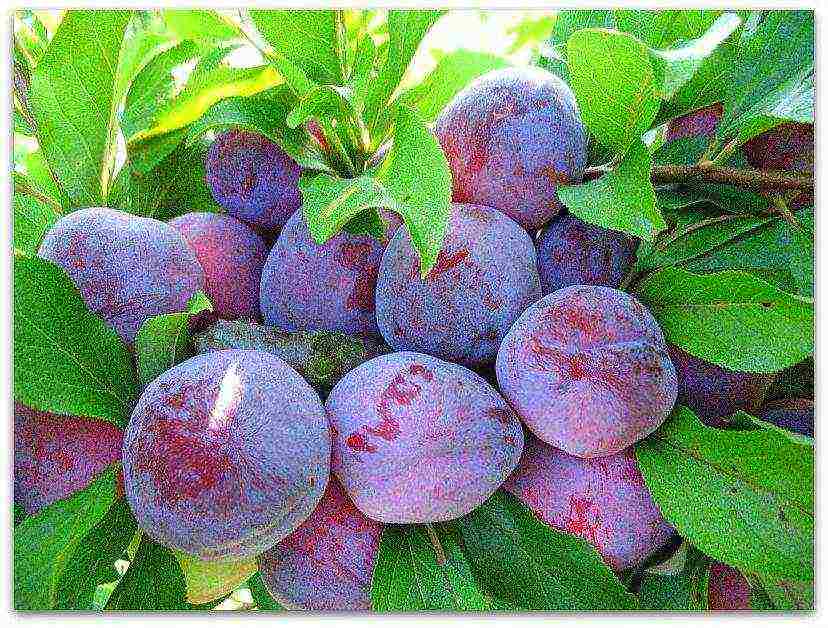
Plum Red Meat
One of the late varieties of the Chinese plum, which combines many varieties. Fruiting begins in mid-August. These are trees of medium height, no higher than 2.5 m, with a crown in the form of a ball.
The plums are dark crimson and weigh about 25 g. The taste is sweet and sour, with a strong aroma. Inside the raspberry pulp there is a small bone that can be easily separated from the main part.
All varieties are self-fertile. As a pollinator, it is recommended to plant other varieties next to Krasnomyasa:
- Early
- Russian plum
The most famous:
- Red meat big
- Red meat resistant
- Red-meat mountain
- Red-meat mid-mountain
- Red meat piedmont
- Red meat drooping
- Red-meat heart-shaped
- Red meat lilac
Let's take a look at some of them.
Red meat big
Red meat drooping
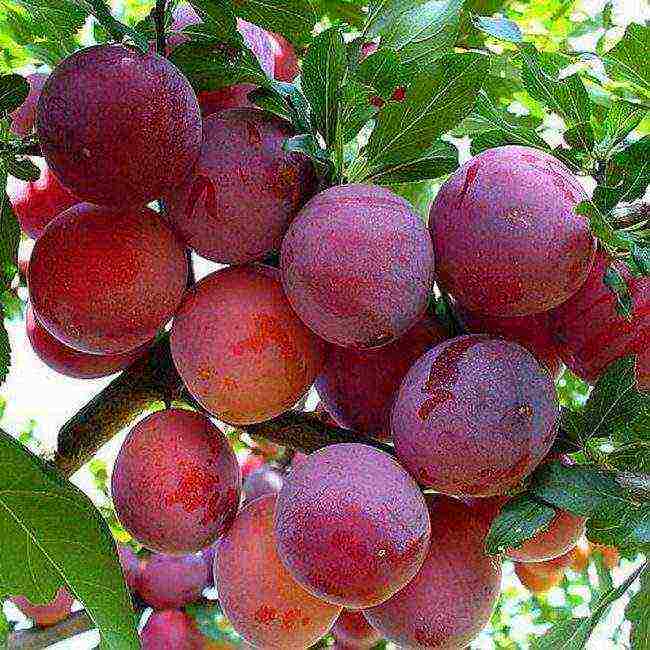
Early varieties
Early varieties of plums allow you to enjoy your favorite fruits until mid-August. They are very juicy, but not too sweet. Let's describe some representatives of this group.
Eurasia
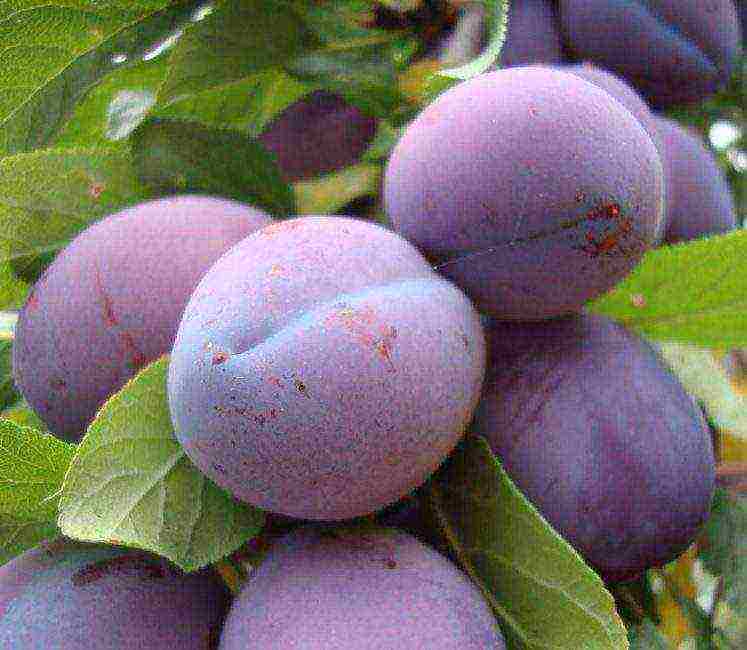
"Eurasia" is not capable of pollinating on its own.
It is recommended to plant the following next to it:
- Volzhskaya beauties
- Memory of Timiryazev
- Renklode Kolkhozny
- Lighthouse
- The Golden Fleece
Starting
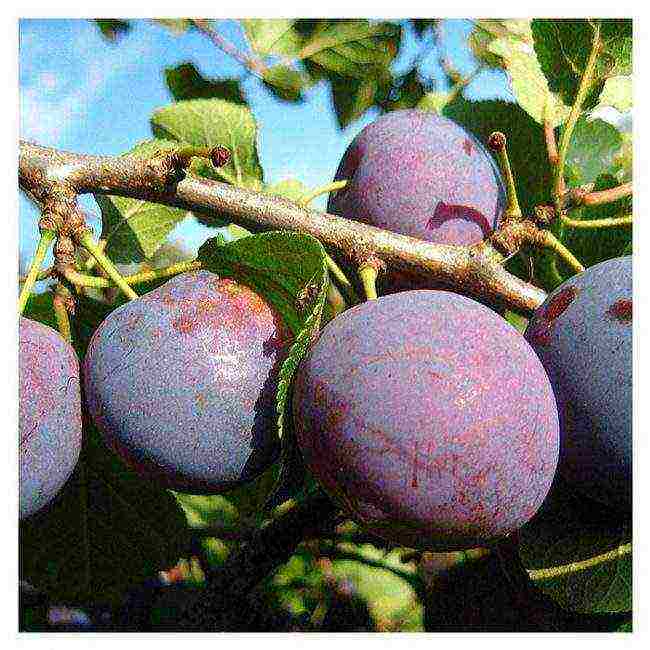
Plum Giant
This variety combines many varieties of large-fruited plum. Their name is associated with a large mass of fruits, which, when ripe, can be up to 110 g.
The trees are strong. The first crop is harvested 3 years after planting, in mid-September. Suitable for long distance transportation.
The fruits can be consumed in any form. The color of the peel, depending on the subspecies, can be either light shades of red or purple. The berries are yellow inside. The seed is difficult to separate from the pulp.
"Giant" does not differ in the sweetness of berries.When planted in central Russia, the plant must be covered for the winter. Low temperatures can affect the size and taste of the fruit.
To obtain high yields, the tree needs regular maintenance.
The most popular varieties of "Giant":
- Top Giant Plus
- Giant Burbank
Giant Burbank
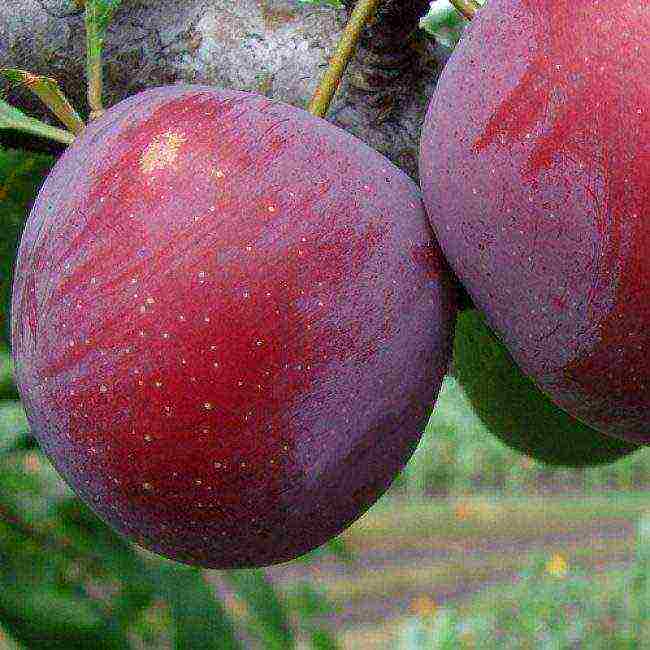
Top Giant Plus
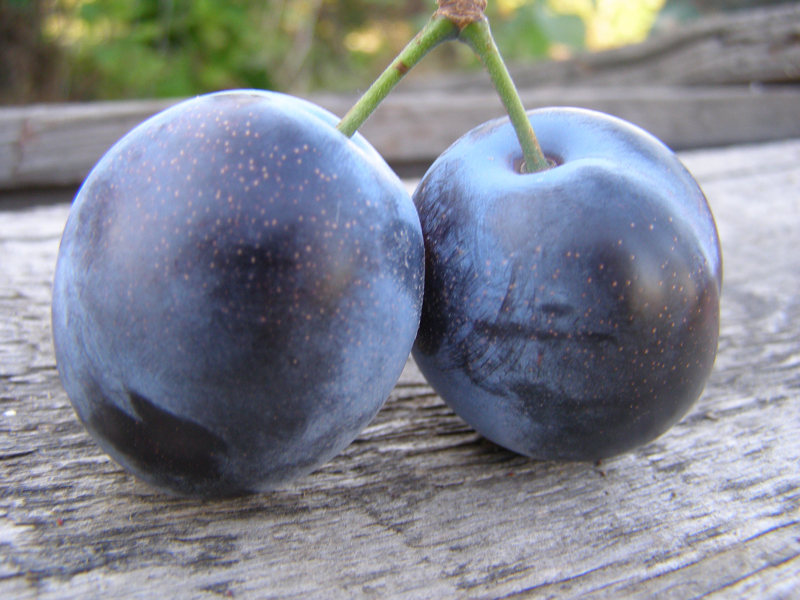
Candy peel
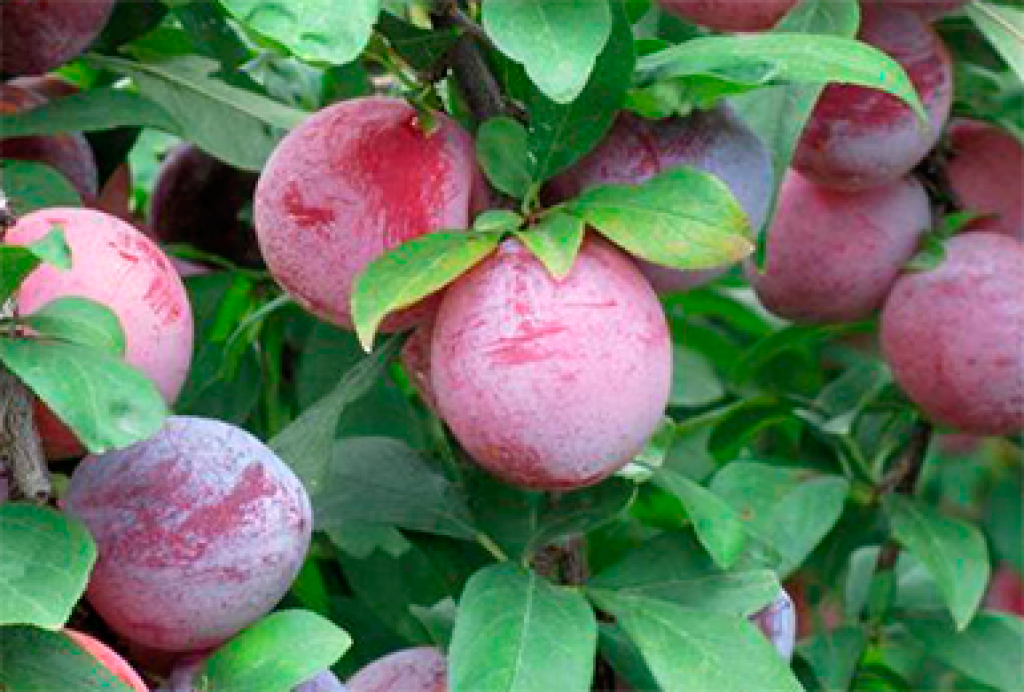
It is recommended to plant next to it such varieties of plums as:
- Kolkhoz renklode
- Columnar
- Zarechnaya early
Plum Peach
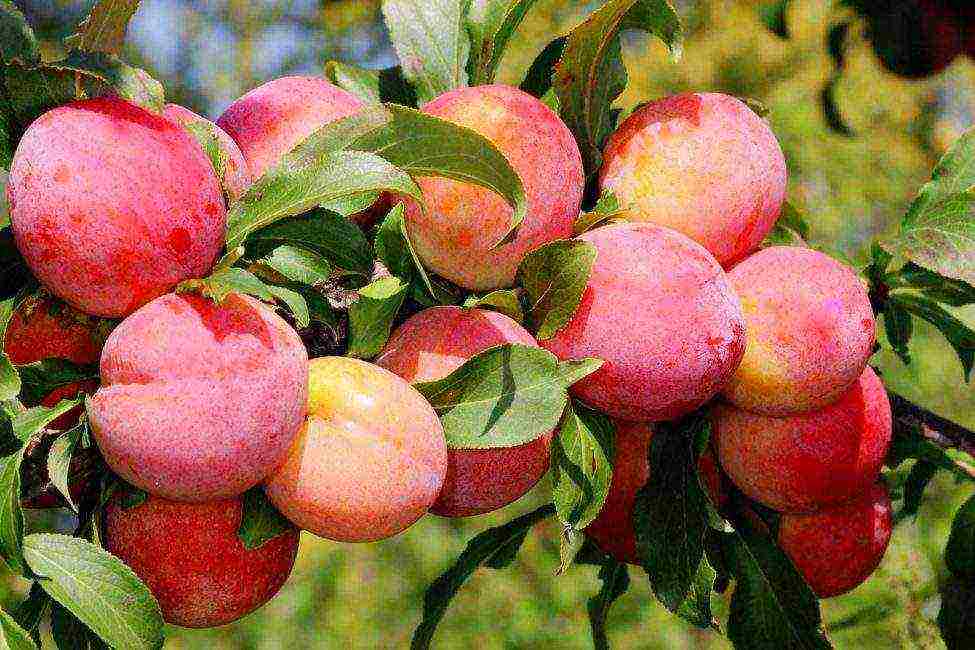
Was bred by French scientists. The variety is not very common in the world, it has several more names - Royal Rouge, Red Nectarine. In Russia, it is found in warm regions.
A medium-sized tree grows up to 4.5 m. It is self-fertile. Needs proximity to other plum varieties.
For example with:
- Mirabello Nancy
- Hungarian
- Anna Shpet
- Renclodom
Peach is a thermophilic culture. She cannot withstand the harsh Russian winters.
Yakhontova
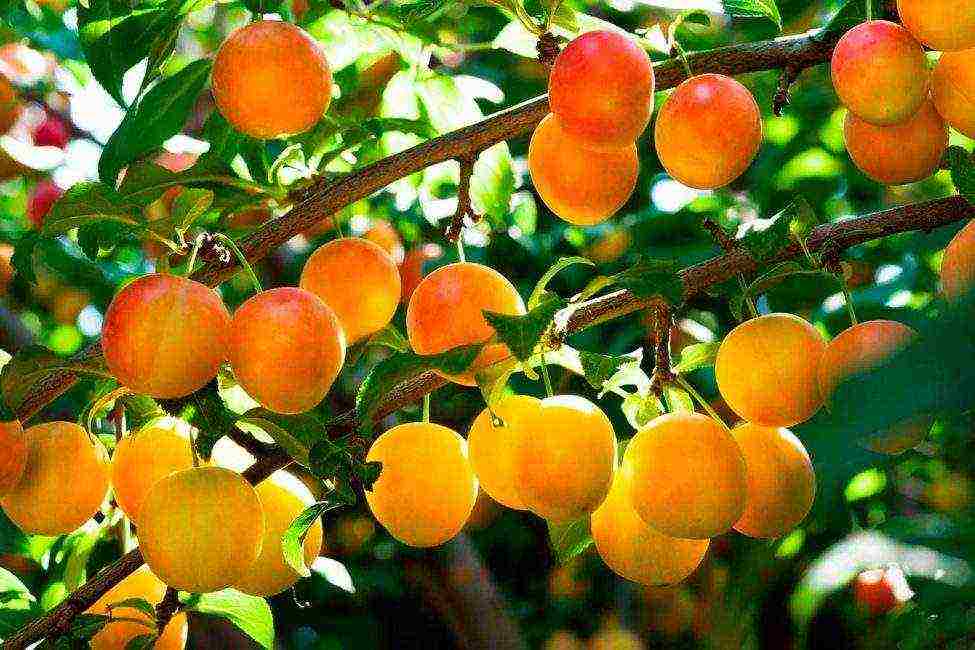
High yields are obtained by planting next to Yakhontova such varieties as:
- Memory of Timiryazev
- Hungarian Moscow
- Early ripening red
The fruits of Yakhontova can be used for harvesting, or consumed in an unprocessed natural form.
Blue
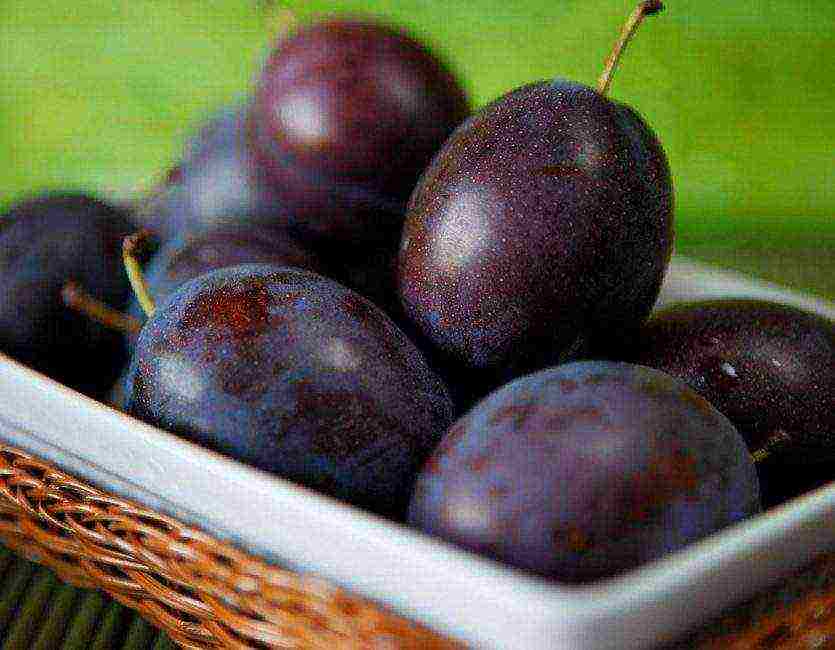
Plum Prunes
Many people know that plums are used to get the well-known dried fruit - prunes. But not all varieties of this crop are suitable for drying.
The most suitable for making prunes are considered to be:
- Hungarian Italian
- Renklod Rososhansky
- Blue bird
- Hungarian Korneevskaya
- Adyghe prune
Dried fruits are obtained only from blue, purple-skinned plums.
Adyghe prune
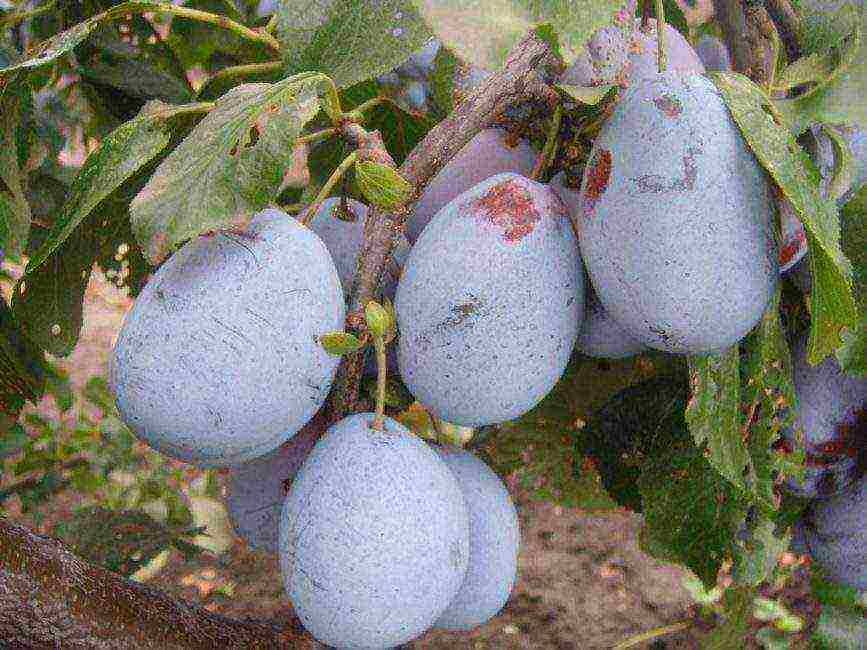
8.6 Total Score
We have tried to collect for you the most popular plum varieties among experienced gardeners and give them a brief but informative description. If you disagree with these ratings, leave your rating in the comments with the reasons for your choice. Thank you for your participation. Your opinion will be useful to other users.
Relevance of information
Reliability of information
9.5
Add your review
Early varieties of homemade plum (until the second half of July) Volzhskaya krasavitsa 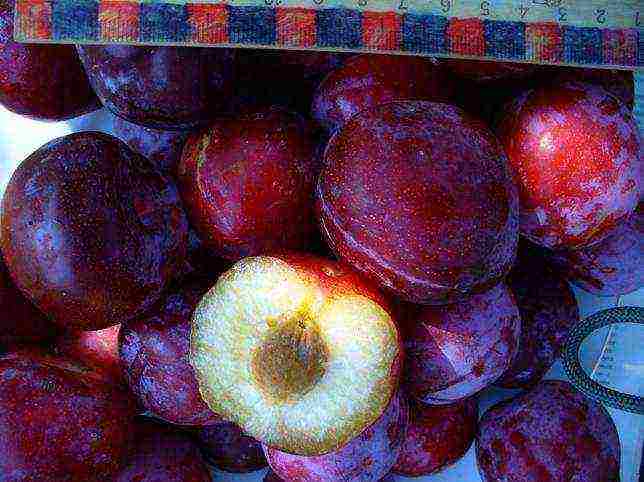
Tall, globular tree, medium dense crown, raised;
Plums up to 40 g are round (slightly elongated), slightly tapered towards the base, red-violet, sweet with pleasant acidity, juicy. The bone is free, the flesh is tender
Central, Lower Volga and Middle Volga regions;
The variety is not afraid of drought and frost, resistance to diseases and pests is average;
Pollinators - Mirnaya, Zhiguli and Skorospelka red Eurasia 21 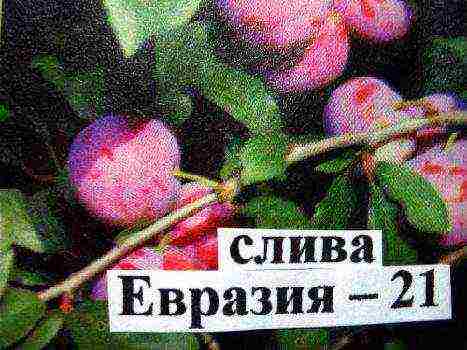
Massive, spreading tree;
Rounded plums (no larger than 30 g), burgundy, sour-sweet, juicy, the stone separates poorly
Central Black Earth Region;
The variety is not afraid of frost, is not affected by diseases and pests. In rainy and cool May weather, the amount of harvest decreases;
Pollinators - Lighthouse, Yielding and collective farm rents, as well as Zarechnaya Early Record 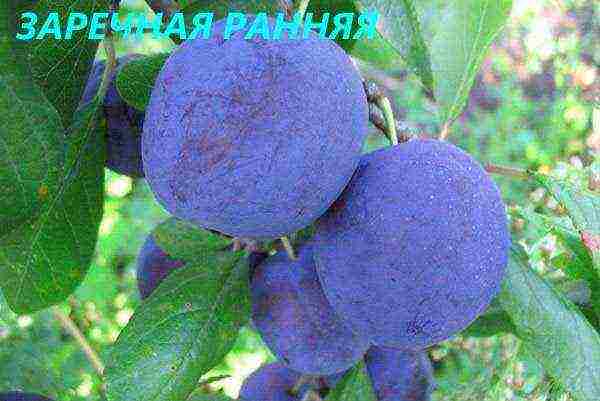
The tree is medium in height, the crown is compact, spherical;
Plums up to 60 g are round, slightly elongated, sweet with a little acid, juicy, dark purple. The pulp is firm, tender, the bone is free
Central Black Earth Region;
Winter hardiness and productivity are high, the variety rarely gets sick and is practically not affected by pests;
Pollinators - Etude, Renklod Tambovsky and others. Early Kabardian (Kabardinka) 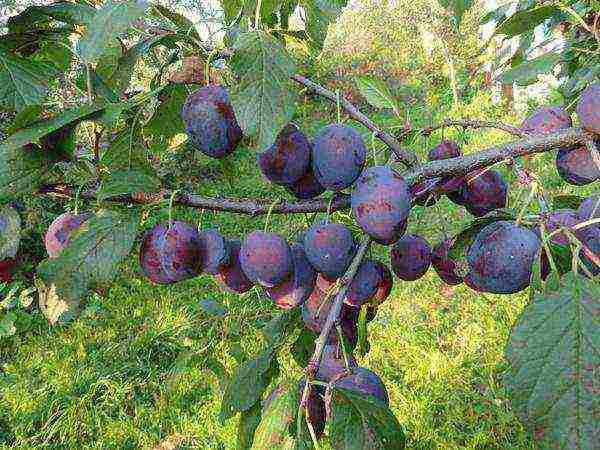
Medium-sized tree with a broadly rounded or pyramidal crown;
Plums are oval, juicy, dark, bluish red, sweet with a little acid. Fruits not larger than 60 g. The pulp is tender, the skin is tough and sour. Loose bone
Resistance to all negative factors is average;
Self-fertile Kyrgyz superb 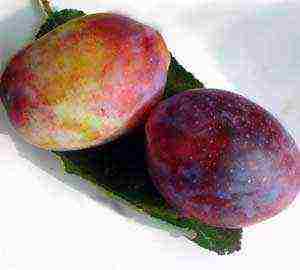
The trees are medium or tall with an oval crown, dense or medium leafy;
Plums up to 70 g are ovoid with an elongated top, juicy, purple, sweet with hardly noticeable acidity. The pulp is tender, the skin is thick, medium-dense, the bone is most often loose
A productive variety. Immunity to frost, pests and diseases is high;
Self-fertile Candy
A low-growing tree with a neat, oval crown;
Plums up to 40 g, elongated, burgundy red, very sweet. The pulp is jelly-like, tender, the skin is thin. The bone is separated freely
Southern regions;
Frost-resistant, high-yielding variety, average resistance to diseases and pests;
Pollinators - Kolkhoz Renklod and Zarechnaya early Favorite of the Sultan (Favorito del Sultano)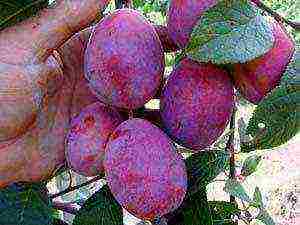
A medium-sized tree with a compact, thinned crown;
Plums up to 70 g, and sometimes up to 110 g elongated-oval, bluish-pink, sweet with a slight acidity, juicy. The pulp is dense, usually the bone is free, rarely - does not separate
Immunity to disease, drought, heat, frost and pests is good. Productivity is very high (branches require supports);
Partial self-fertility Honey white or yellow 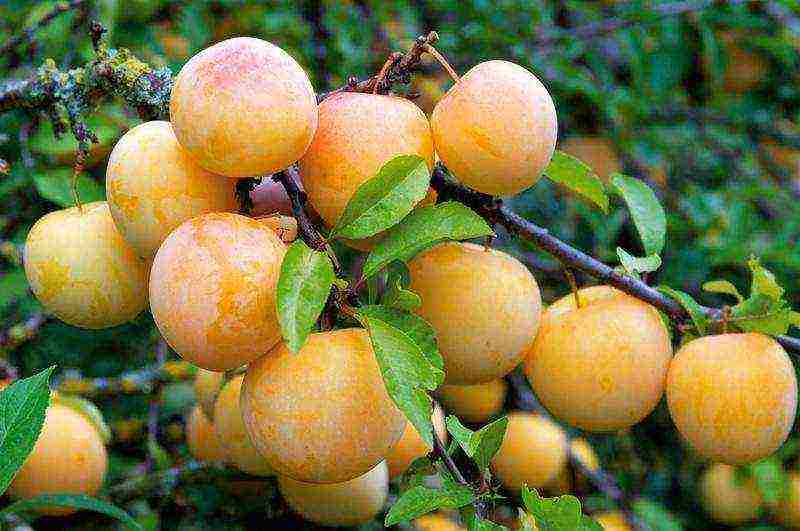
Tall tree with an oval, thin, crown;
Plums up to 50 g, yellow with an orange-pink barrel, round, very sweet with a slight sourness, juicy. The skin and flesh are firm, the bone is separated by half
Central Black Earth region, as well as the variety is developing well in the Moscow region;
Immunity to various negative factors is excellent, unpretentious, high-yielding variety;
Pollinators - Early Donetsk and Donetsk Hungarians, Renklod Karbysheva Nenka 
Medium-sized, round, medium-dense tree;
Plums up to 60 g are sour-sweet, juicy, barrel-shaped, dark, red-violet. The skin is medium-dense, the pulp is sinewy, medium-dense. Free bone
A productive and unpretentious variety, resistant to frost, does not get sick and is not affected by pests;
Partial self-fertility Opal 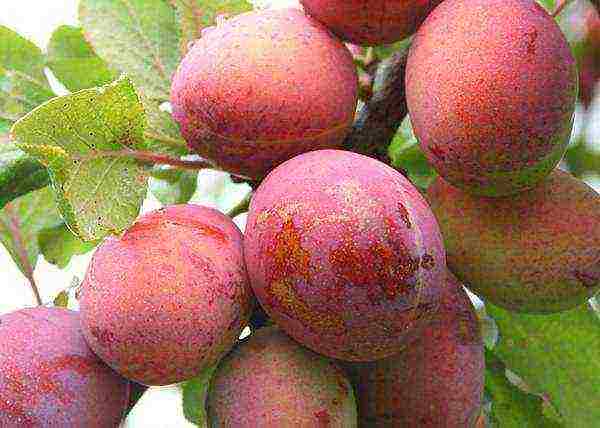
Medium in height, round, thickened, compact tree;
Plums up to 60 g are round, slightly elongated, sour-sweet, juicy. The color is orange-red, the skin is thin, the flesh is firm, the bone is free
Southern regions;
Frost resistance is weak, the harvest is unstable. The variety is rarely affected by diseases and pests;
Partially self-fertile Peach
A medium-sized tree with a rounded, medium-leaved, thin crown;
Plums up to 45 g, sometimes up to 70 g round, sweet with light acid, juicy. The color is yellow-green with a red flank. The pulp is firm, the bone is free
All regions;
A high-yielding variety, moderately resistant to low temperatures, does not get sick and is not affected by pests. In cold regions, requires shelter;
Pollinators - Green and Altana Renklodes, Azhansk and home Hungarians, as well as Anna Shpet and Mirabel Nancy Renklode collective farm 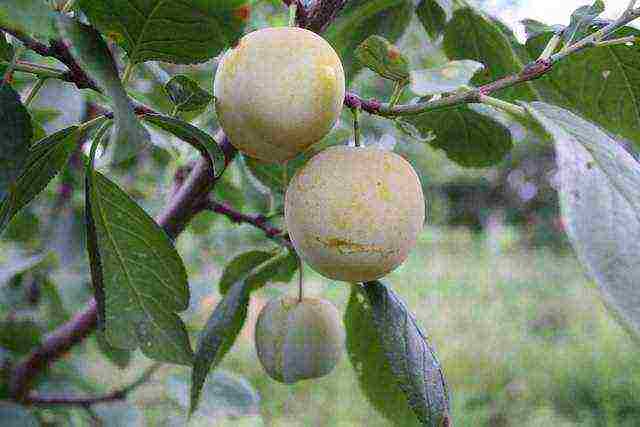
Medium-sized, round, medium-dense, spreading tree;
Plums no larger than 30 g are sour-sweet, yellow, juicy, round in shape. The skin tastes a little bitter. The pulp is medium-dense, very tender, the bone is separated by half
Central Black Earth, Central and North-Western regions;
A productive variety, resistant to all negative factors;
Pollinators - Hungarians Moscow and Pulkovskaya, Renklode of thorns, Eurasia 21, Skorospelka red and Volga beauty Renklode early 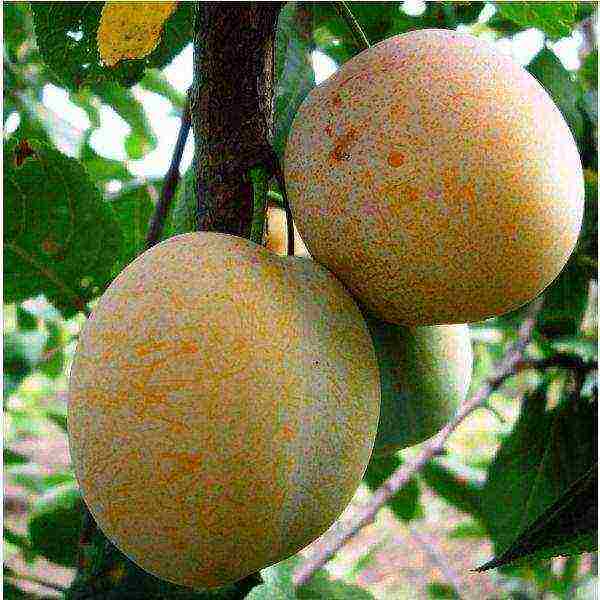
Tall tree with medium-dense crown;
Plums no larger than 60 g are round, yellow, sometimes with an orange barrel, sweet with hardly noticeable acidity and a strong honey aroma, juicy. The skin is dense, the flesh is medium-dense. The bone does not come off
Productivity, resistance to low temperatures and drought are high, good resistance to diseases and pests;
Pollinators - Hungarian Donetsk and Donetsk early, Renklod Karbysheva Sinilga or Daughter of Sinilga 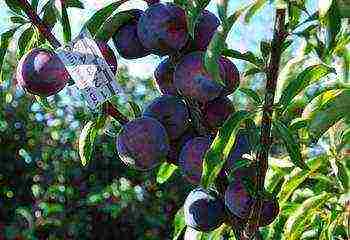
Vigorous, pyramidal tree;
Plums are dark, violet-blue, sweet and sour, rounded (no larger than 30 g). The pulp is dense, dryish, the bone is free
The variety is suitable for growing in the middle lane and even in Siberia;
Resistance to various negative factors is above average;
Self-sterile, all plum blossoming at the same time are suitable for pollination. 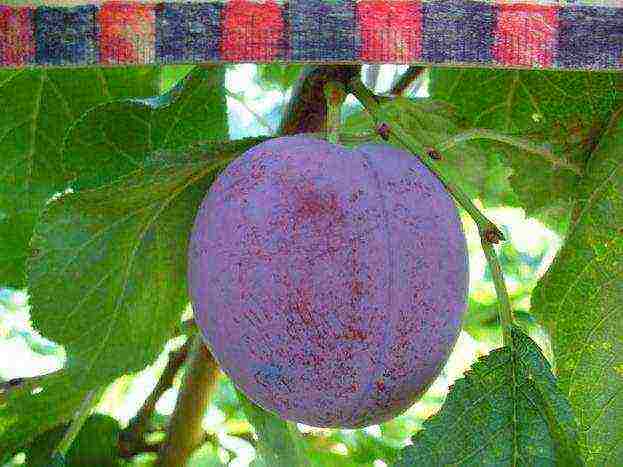
Medium-sized, dense tree with a broadly oval, medium-leafed crown;
Plums, red-purple, sweet and sour, juicy, rounded (up to 60 g). The skin is medium in thickness, the stone is detachable
Central Black Earth Region;
Average yield, excellent immunity to all negative factors;
Pollinators - varieties simultaneously blooming home plum Morning 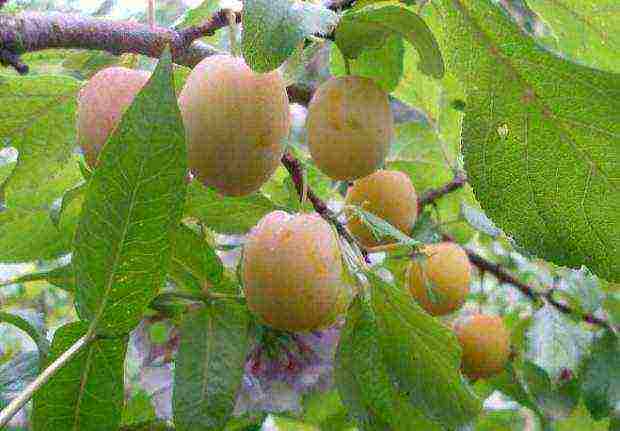
A short, dense tree with an oval crown;
Plums up to 30 g are oval, light green with a pinkish barrel, sour-sweet. The pulp is slightly fibrous, not particularly dense and juicy, slightly sugary
Central region;
Plum Morning is moderately resistant to all negative factors;
Self-Fertile Study 
Medium-sized, rounded tree;
Plums up to 30 g are round, slightly elongated, dark red-purple, sweet and juicy. The skin is medium-dense, thick, the flesh is firm, the stone does not separate
Central Black Earth Region;
Immunity to frost, drought, typical diseases and pests is high;
Pollinators - Renklod Tambovsky, Zarechnaya early and Volzhskaya beauty Mid-season varieties (from mid-July to the second half of August) Amers 
Medium-sized, rare tree;
Plums up to 60 g oval-flattened, burgundy - purple, sweet and sour. The pulp resembles an apricot in consistency, slightly cartilaginous, the stone is free
Sun-loving variety with excellent immunity to all negative factors, except for moniliosis. The yield is consistently high;
Pollinators - Bluefrey, Stanley, Niybolia and Empress Black Amber 
Medium in height, compact tree;
Plums up to 150 g are round, slightly flattened at the bottom and top, sweet (with hints of peach), dark blue, juicy. The pulp is firm, the bone does not separate
A productive variety, does not get sick and is not afraid of frost;
Pollinators - Santa Rosa, Golden Plumza and Friar Blue Sweet 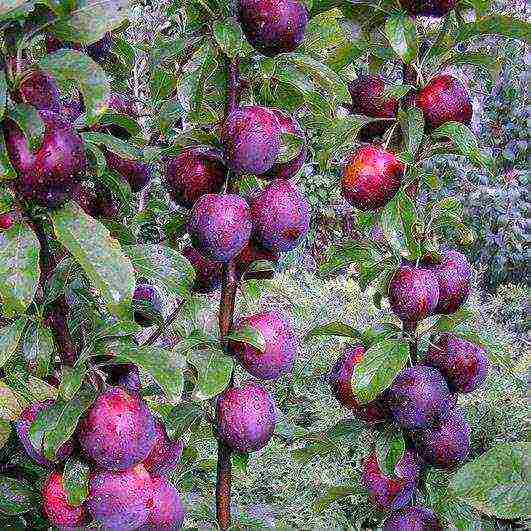
Columnar plum. The tree is tall, the crown is up to 90 cm in diameter;
Plums up to 75 g, slightly squeezed oval, sweet and sour, pink-purple, juicy. Detachable bone
A productive and frost-resistant variety, does not get sick and is not interesting for pests;
Pollinators - Stanley and Blue Free Heroic 
Medium-sized, branched tree;
Plums up to 50 g elongated-oval, lilac-purple, juicy, sweet with hardly noticeable acid. The pulp is cartilaginous, but tender, the bone is separated by half
Medium resistant to stone fruit diseases and pests, a variety with high productivity and winter hardiness;
Self-fertile Victoria (Queen Victoria)
The tree is tall, massive, the crown is raised with hanging flexible branches;
Plums up to 36 g are ovoid, pale golden with wine blush, sweet with pleasant acidity, juicy. The pulp is moderately dense, the bone does not separate
Medium resistant variety in all respects;
The variety was awarded the "Merit of the Garden" prize in 1993 and 2013;
Pollinators - Anna Shpet, Kirke, Peach, Hungarian Azhanskaya, Green Renklody and Altana Voloshka 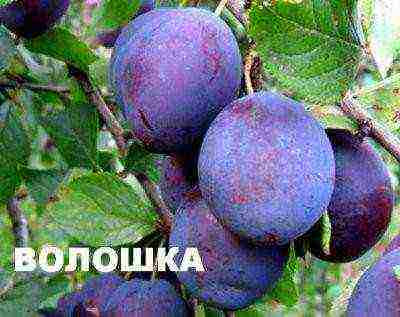
A vigorous tree with a broadly rounded crown;
Fruits are oval 30 g with a dark blue skin with a waxy bloom. The pulp is juicy, yellow-green in color, well separated from the stone
North Caucasian region;
Medium disease resistant, average winter hardiness;
Self-fertile Yellow self-fertile 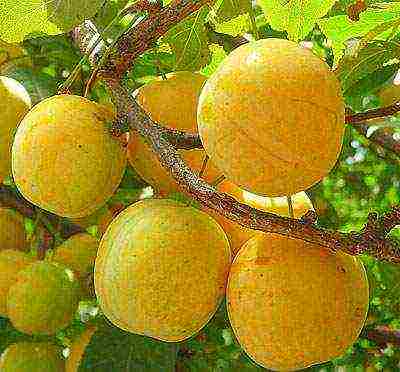
The tree is tall, the crown is massive, spreading, not thickened;
Plums no larger than 30 g are round, yellow, aromatic, juicy, sweet with a little acid. The skin is dense, the flesh is medium-dense
High-yielding, winter-hardy variety, practically does not get sick and is rarely affected by pests;
The variety is self-fertile, but for a larger harvest, you can plant a couple of simultaneously flowering Imperial varieties nearby 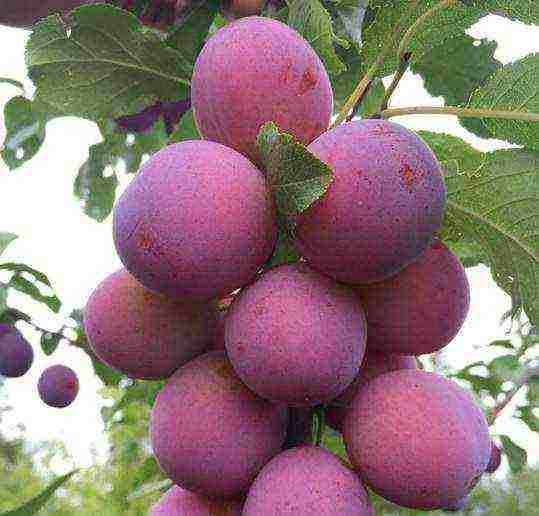
Columnar plum. Small, compact tree with little branching and a pyramidal crown;
Plums are round, slightly elongated, pinkish-lilac, sour-sweet, juicy (up to 60 g). The pulp is sugary, the skin is thick. The bone is separated in half
The yield is high. Variety medium resistant to all negative factors;
Pollinators - Bluefrey, Renclaude Altana and Stanley Gigantic
Tall, thickened tree with a pyramidal crown;
Plums up to 60 g obovate, lilac-red, sour-sweet, juicy. The skin and flesh are firm. The stone will be free if the plum is properly watered
The yield is consistently good. Resistance to disease, drought, pests and frost is average;
Self-fertile cooperative
Medium-sized, densely leafy, wide tree with a rounded crown;
Plums are oval, purple-red, juicy, sweet and sour with a pleasant aroma (no larger than 40 g). Free bone
Immunity to frost, typical diseases and various pests is high. Unpretentious and productive variety;
Pollinators - varieties of home plum of one flowering period Hungarian Korneevskaya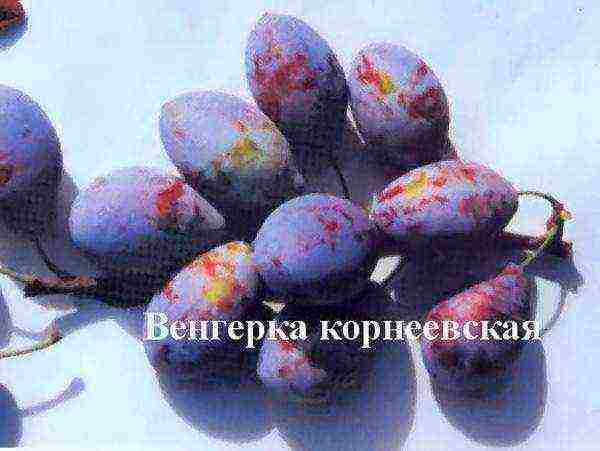
Medium tree with a spreading, densely leafy crown;
Oval plums with a narrowed tip, violet-brown, sweet, juicy, maximum weight 40 g. The pulp is tender, the stone is free
A productive variety, resistant to short-term drought, has good immunity to diseases, pests and frost;
Self-fertile Crooman 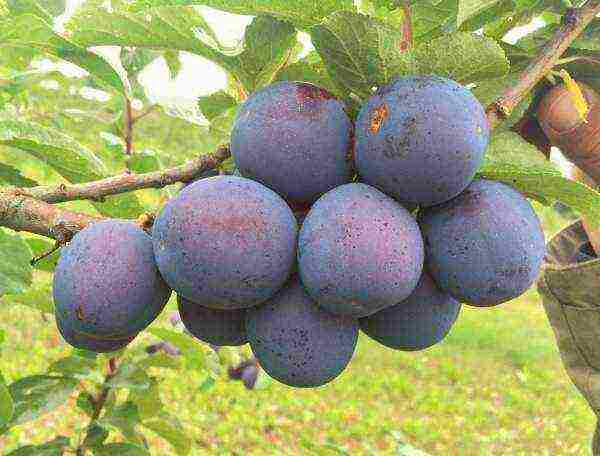
A low, rare tree with a rounded crown;
Plums are rounded, red-violet, sweet, no larger than 40 g. The pulp is firm, the stone is free
Central region;
Stable in all respects, productive variety;
Self-fertile Mashenka 
Tall, pyramidal tree;
Plums are oval, sour-sweet, brown, juicy (maximum weight 50 g). The pulp is tender, the skin is thin, the bone is free
Central region;
Winter-hardy, productive variety with good immunity to stone fruit diseases and pests;
Pollinators - Skorospelka red, Lighthouse, In memory of Timiryazev and Renklod Mirnaya 
Medium-dense, actively growing tree with a rounded, slightly elongated crown;
Plums up to 40 g are dark brown-violet, round, homogeneous, sour-sweet, juicy. The skin is medium-dense, the pulp is tender bone, loose
Lower Volga and Middle Volga regions;
A productive variety, resistant to all negative factors;
Pollinators - Kuibyshevskaya blue, Zhiguli, Ternosliv Kuibyshevskaya and Skorospelka red Nika 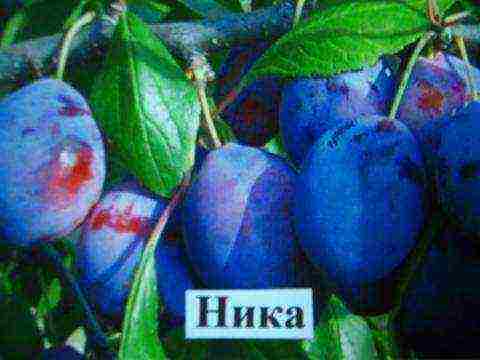
Tall, medium-dense, spreading tree with a broadly oval crown;
Plums are oval, elongated, violet-blue, dark, sweet with hardly noticeable acidity and astringency, juicy (up to 60 g). The pulp is tender, the bone is free
Central Black Earth Region;
Variety resistant in all respects;
Pollinators - Early Donetsk and Donetsk Hungarians, as well as Soviet Renklod in Memory of Vavilov 
An average tree in all respects with a wide-rounded crown;
Plums are juicy, round, isosceles, golden yellow, sweet (no larger than 55 g). The skin is tender, the flesh is jelly-like, the bone is free
Yielding variety, medium resistant to various negative factors;
Pollinators - Rival, President, Early Kabardian and Renclode Altana Memory of Timiryazev 
The tree is average in all respects, bushy;
Plums are ovoid, yellow with a red barrel, sweet and sour, juicy, not larger than 40 g. The pulp is granular, dense.
Middle Volga and Central regions;
Resistance to low temperatures, drought, diseases and pests is average;
Self-fertile Renclaude Altana 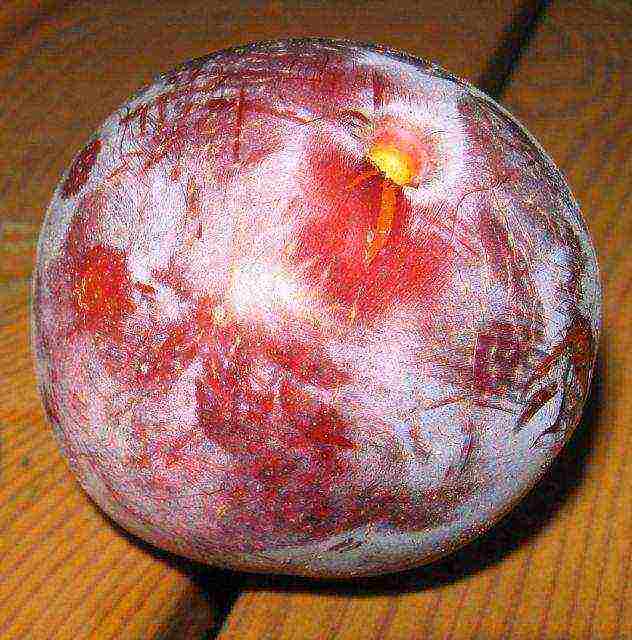
Tall, oval-rounded, not thickened tree;
Plums are pinkish-red, round, sour-sweet, juicy (no larger than 45 g). The skin is thin, dense, the flesh is dense, slightly fibrous. Free bone
Lower Volga and North Caucasian regions;
High-yielding variety, resistant in all respects;
Pollinators - Hungarian homemade, Azhansk and Italian, as well as varieties such as Kirke, Grand Duke, Catherine, Victoria and Anna Shpet Soviet Renklode 
A low broom-shaped tree with a non-thickened, wide-pyramidal crown;
Plums are round, juicy, purple (almost black), sweet with a little acid. Maximum weight 80 g, tender pulp, loose bone
Central Black Earth Region;
Resistant to all negative factors, high-yielding variety;
Pollinators - any Renclode Firefly 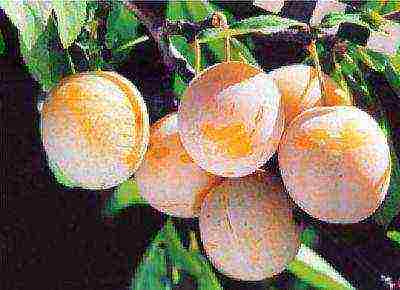
Medium-sized, spreading tree with a raised-oval crown;
Plums are broadly oval, light yellow, sweet and sour, juicy (no larger than 45 g). The skin is medium thick, the bone is loose
Central Black Earth Region;
A productive variety, does not suffer from low temperatures, diseases, short-term drought and pests;
Pollinators - Lighthouse, Record, Collective farm and fruitful plant reeds Blue gift 
Average in all respects, oval, slightly raised tree;
Plums are blue-violet, almost black, sour-sweet, juicy, oval (up to 25 g). The pulp is granular, slightly fibrous, dense
Central region;
Immunity to all negative factors is a weak, productive variety;
Self-fertile bluebird 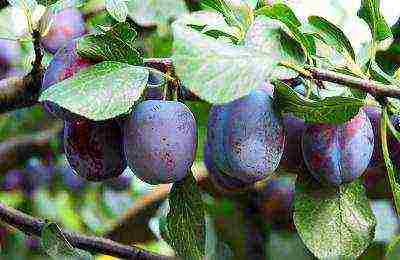
Tall, not thickened tree with a rounded crown;
Plums are large, reddish-purple, broadly oval, sweet. The pulp is firm, the bone is free
North Caucasian region;
The yield is high, the variety does not get sick and is not damaged by pests;
Self-fertile Smolinka 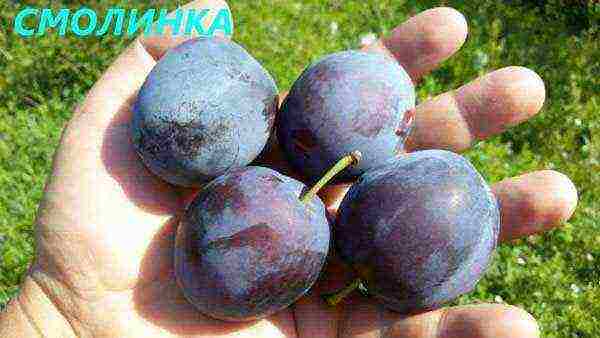
Tall, neat tree with an oval crown;
Plums are violet-blue, sweet, juicy, rounded, slightly elongated (no larger than 45 g). The skin is medium thick, the flesh is tender, the stone is separated by half
Central region;
Variety medium resistant to all negative factors;
Pollinators - Moscow Hungarian, Blue Dar, Volga Beauty, Egg Blue and Super Early, as well as Morning and Opal Adyghe Prune 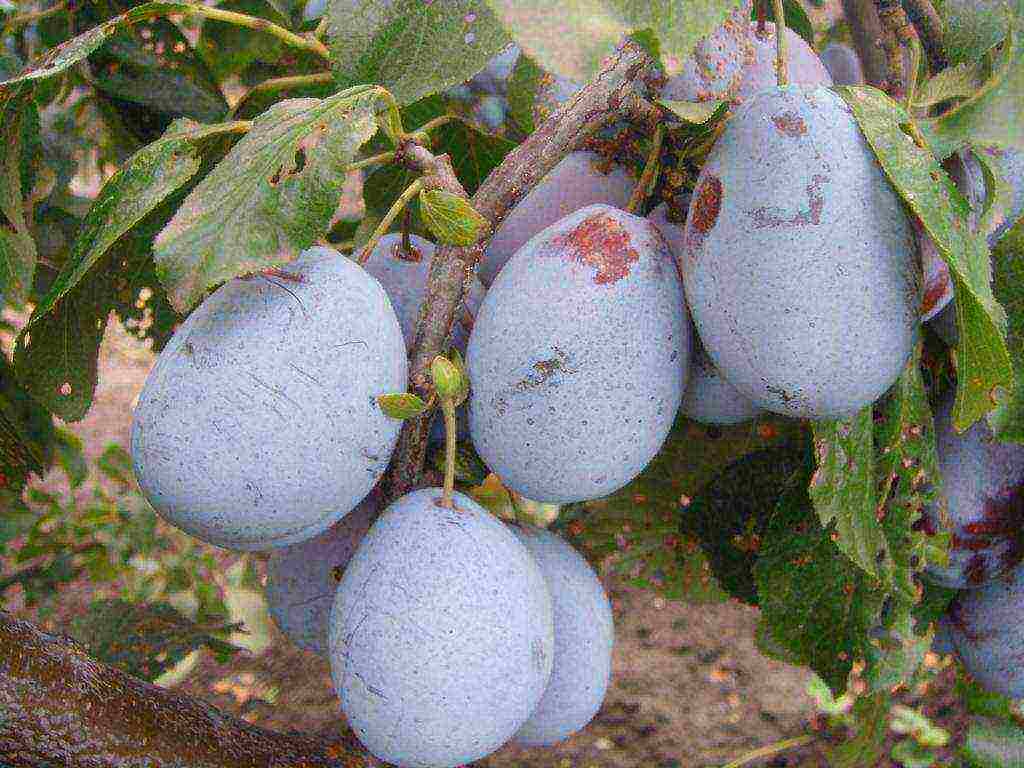
A tall, medium-branched tree with an oval, sparsely leafy crown;
Plums are small, elongated-rounded, sour-sweet, juicy, purple. The skin is sour with bitterness, thick, dense, granular-fibrous pulp. The bone separates well
North Caucasian region;
Good immunity to typical diseases, the variety is not afraid of frost;
Self-fertile egg blue 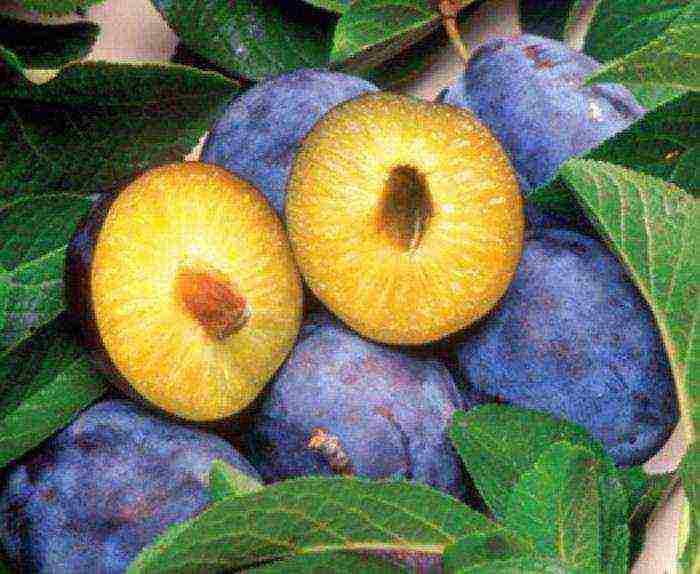
The tree is tall, thin, spreading, medium-leafy, oval crown;
Plums are sweet and sour, juicy, reddish-purple, ovoid (up to 45 g). The skin is thin, elastic, fibrous pulp, medium dense. Detachable bone
Central region;
Variety resistant to all negative factors;
Self-fertile Yakhontova 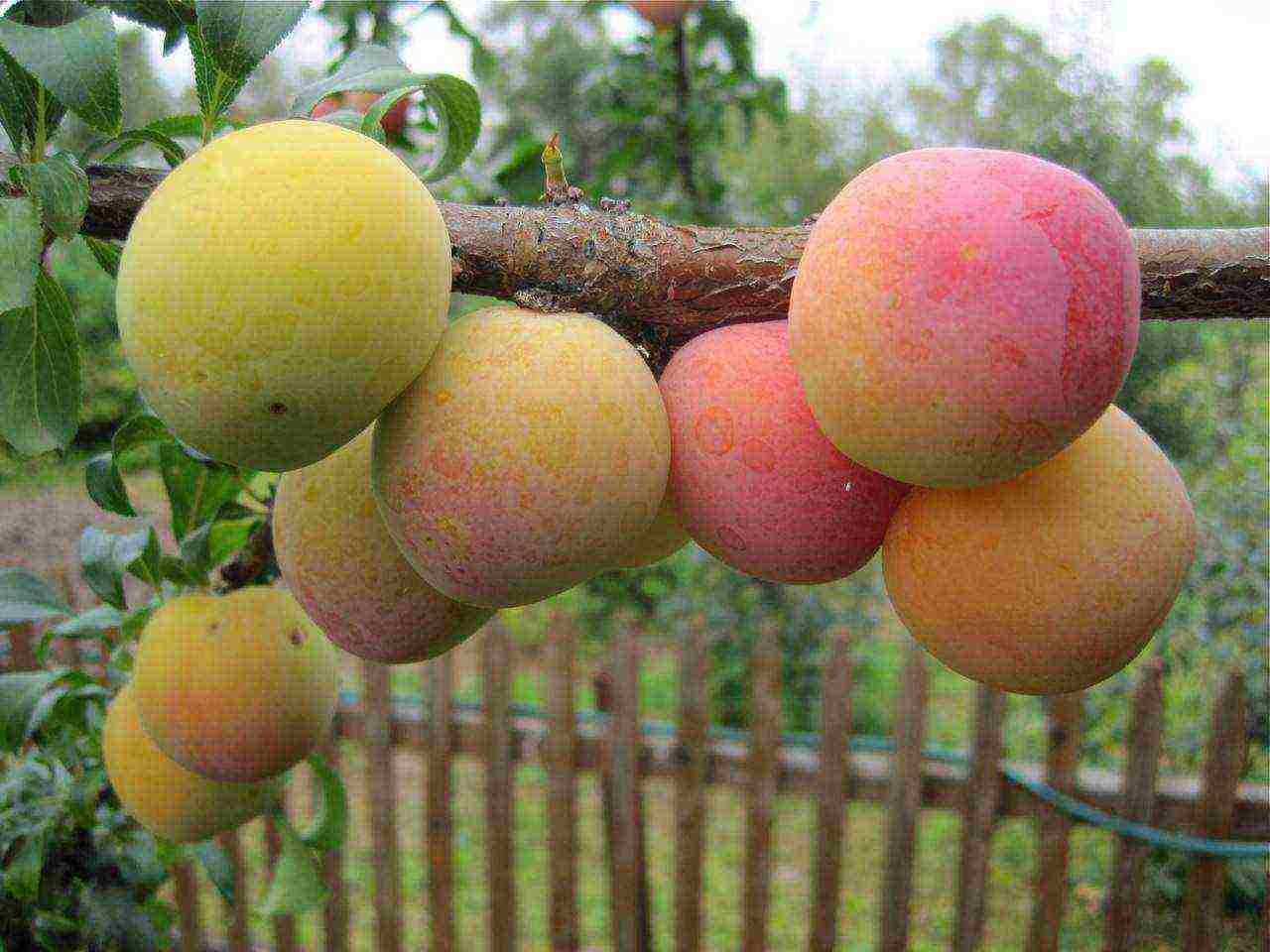
Tall, thin, compact tree with a rounded crown;
Plums are round, sometimes slightly elongated, light green-orange with a pinkish barrel, sour-sweet, juicy. The skin is thin, the flesh is tender, the bone is free. Maximum fruit weight 35 g
The variety is not afraid of frost, does not get sick and is not affected by pests;
Pollinators - Skorospelka red, Hungarian Moscow and Pamyat Timiryazeva Late varieties of domestic plum (from the second half of August to mid-October) Anna Shpet
The tree is tall, strong with a wide-pyramidal crown;
Plums are broadly ovate, sometimes oval, large, violet-red, sweet and sour, juicy. The pulp is fibrous, loose, dense, the skin is thin
Lower Volga and North Caucasian regions;
A high-yielding variety, moderately resistant to frost, drought and disease;
Pollinators - Victoria, Kirke, Ekaterina, Early Hungarian, Washington. Renklods Altana and Green Blue Free
Tall, rare, sprawling tree with a rounded crown, actively develops until the first harvests, then grows slowly;
Plums up to 100 g are oval, wide, purple (almost black), sweet with light acid, juicy. The pulp is tender, very dense, the bone does not separate
Productivity, resistance to frost and pests is high, immunity to diseases is average;
Pollinators - President, Stanley and Empress, Anna Shpet, Vision, Opal. Viretu and Rusch Gerstetter Hungarian Moscow or Tsaritsyn 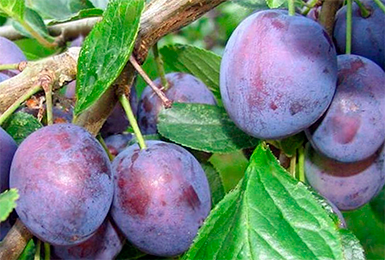
Medium-sized, spreading, dense tree with a rounded crown;
Plums up to 35 g are ovoid, reddish-purple, sweet and sour, juicy. The skin is coarse with a slight bitterness, the pulp is firm, the bone is free
Central region;
Variety resistant to all negative factors;
Self-fertile Vision or Vision 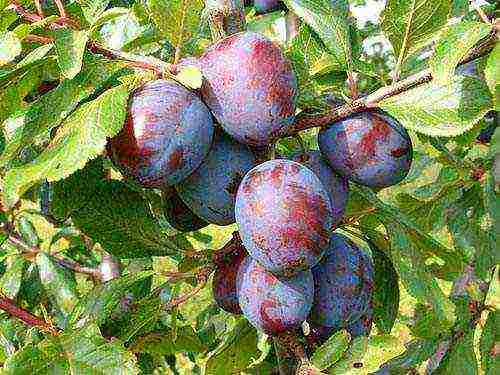
The tree is tall, the crown is round, dense;
Plums are large, oblong-oval, sweet, dark red. The pulp is dense, juicy. The bone is separated freely
A productive, resistant to various negative factors variety with good immunity to diseases and pests;
There are data on the grafting of the variety on the felt cherry to reduce growth;
Pollinators - Stanley and President Volat 
Medium-sized tree with a dense, rounded crown;
Plums are obovate, elongated, blue-violet, sweet and sour, juicy (up to 70 g). The skin is dense, the bone is free
The variety does not get sick and is practically not affected by pests, fruitful and frost-resistant;
Pollinators - Favorito del Sultano and Belarusian General's Hungarian 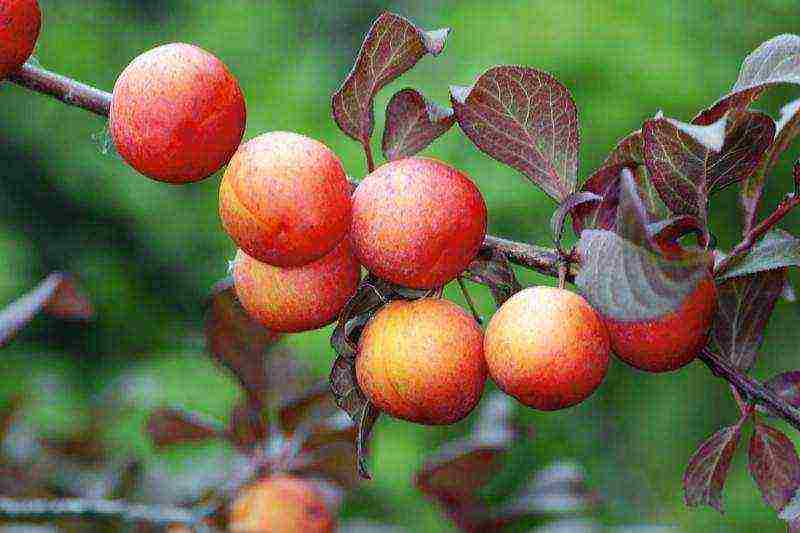
Medium, dense, compact tree with a medium spreading crown;
Plums up to 50 g wide-rounded, yellow-orange with a pink barrel, juicy, sour-sweet. The skin is strong, the flesh is firm, the stone is detachable
A high-yielding variety with excellent immunity to diseases, sometimes affected by pests, not afraid of frost;
Pollinators - Ural red and others.Dashenka
Medium-sized, medium-dense tree with a pyramidal crown;
Plums are round, almost black, sour-sweet, juicy (no larger than 50 g). The skin is thin, medium-dense, fibrous pulp, tender. The bone is separated in half
Northern regions, suitable for the middle lane;
A productive variety, resistant to all negative factors;
Partially self-fertile President 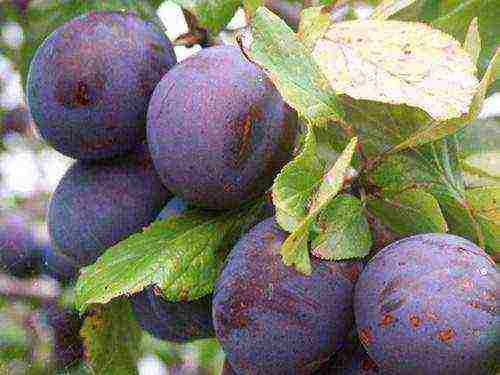
Medium-sized, thin tree with a rounded-oval crown;
Plums are roundish, blue-lilac, sour-sweet, juicy (up to 50 g). The skin is medium-dense, the flesh is tender, the bone is free
A productive variety with good immunity to low temperatures, practically does not get sick, rarely affected by aphids;
Pollinators - Mirnaya, Ternosliv Kuibyshevskaya and Skorospelka red Renklod Tambovskiy 
Medium-sized, spreading, sparse tree with a broadly oval crown;
Plums up to 45 g are round, elongated, brown-violet (almost black), sweet and sour, juicy. The bone is separated in half
Central and southern regions;
Frost-resistant, productive variety, often sick and affected by pests;
Pollinators - Skorospelka red, Renklody green and collective farm Stanley or Stanley 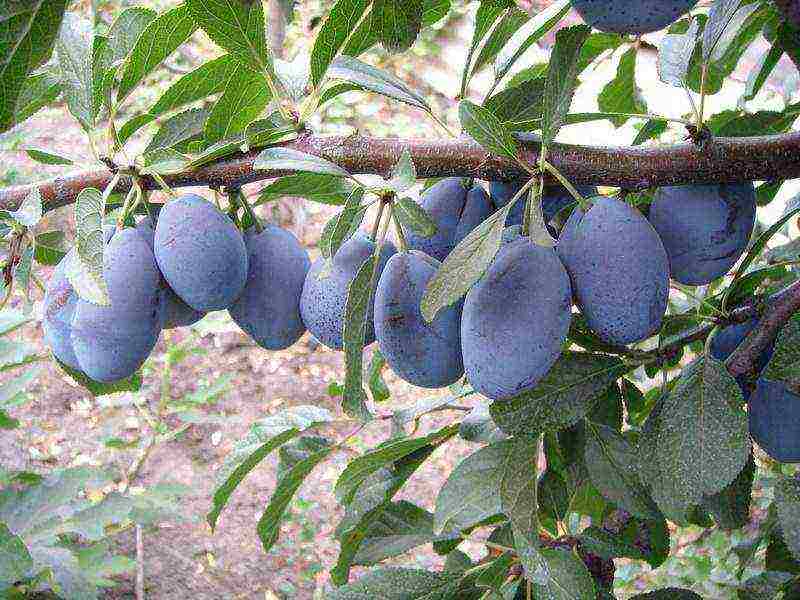
Medium-sized tree with a rounded, thinned crown;
Plums are obovate, violet-blue, sweet and sour, juicy (up to 50 g). The skin is medium thick, the pulp is granular and fibrous, dense. Free bone
North Caucasian region;
Variety medium resistant to all negative factors;
Pollinators - President and Express Top Hit 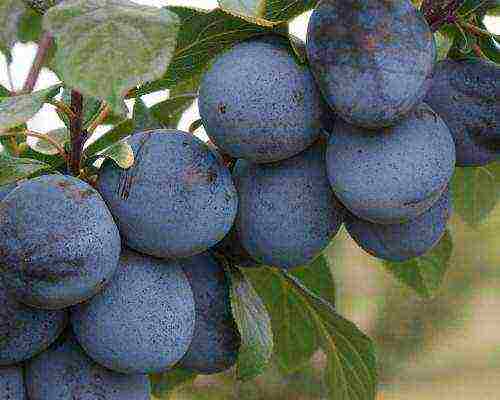
Tall tree with a spreading crown;
Plums are sweet with pleasant acidity, dark purple, oval, elongated (up to 100 g). The pulp is firm, the bone is free
Resistance to low temperatures and typical diseases is high;
Self-fertile Tula black 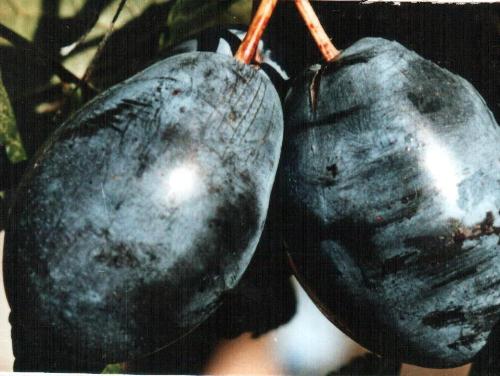
A compact tree with an oval, thickened crown;
Plums are round-ovoid, blue (almost black), sweet and sour, juicy (up to 35 g). The skin is thin, the flesh is medium-dense
Immunity to low temperatures, drought and typical diseases is average;
Self-fertile


